







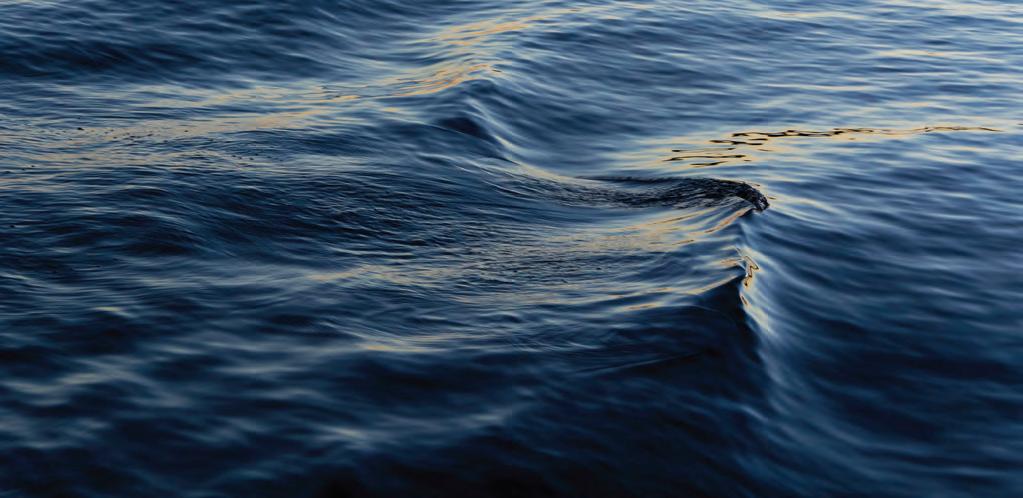
ALEXANDER MARINE USA offers an unrivaled premier selection of new yachts on the West Coast, as well as an extensive selection of pre-enjoyed yachts from coast to coast. Our promise is to put you in the ideal yacht to match your discerning lifestyle. From initial contact to final contract, our expert staff will serve with integrity, competence, and confidentiality. Join us on the journey to making your yacht dreams a reality. Contact us today to get started...







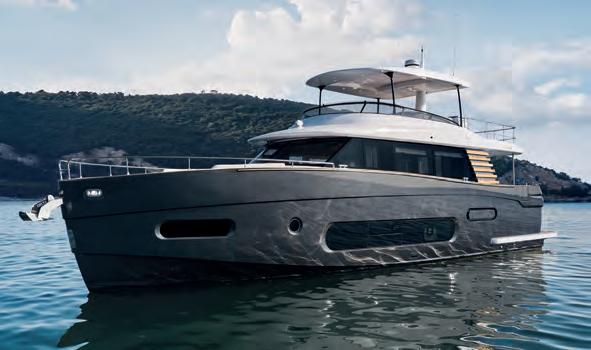
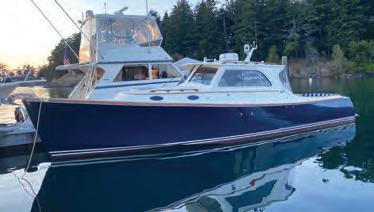
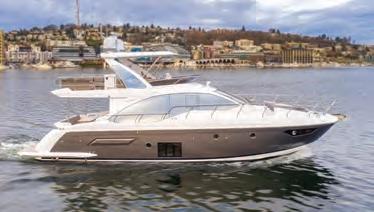


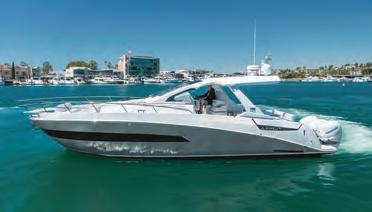
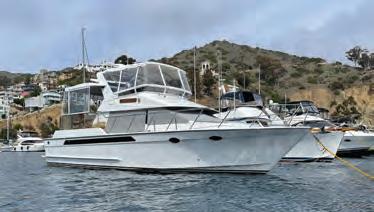
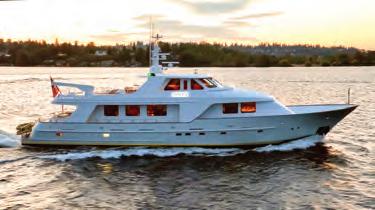
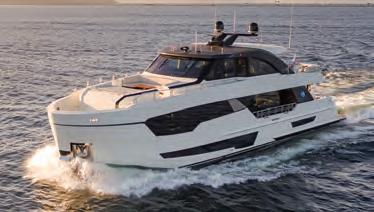


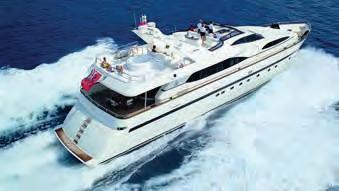

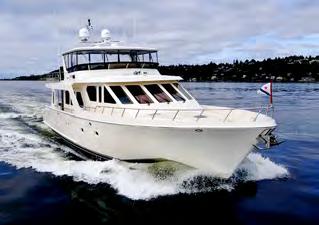

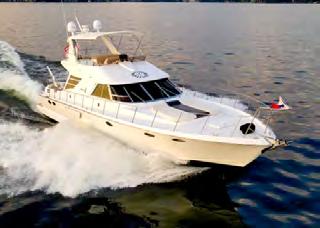
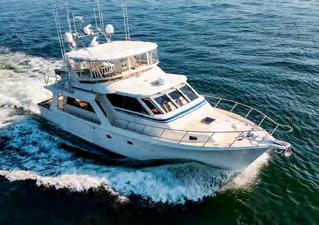

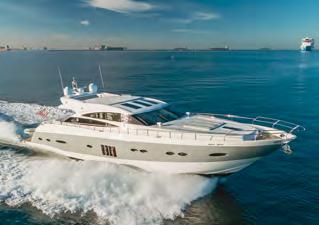





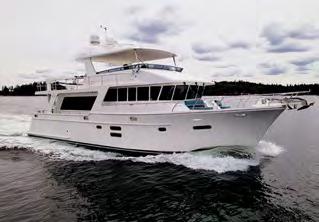
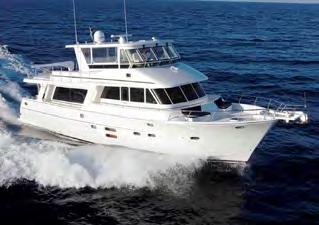
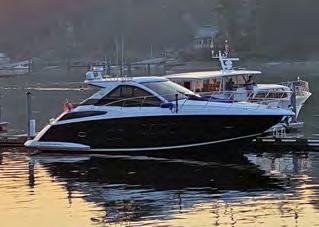
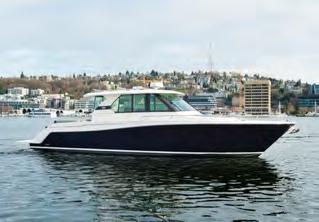



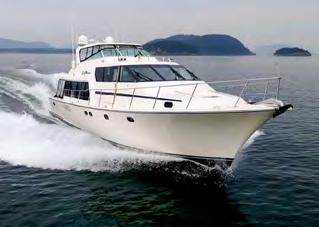
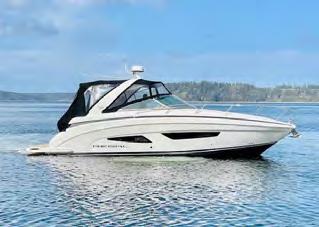
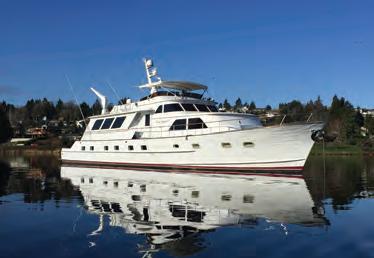

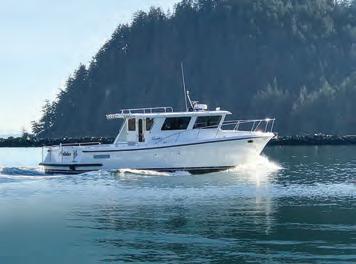
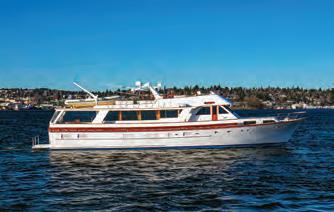


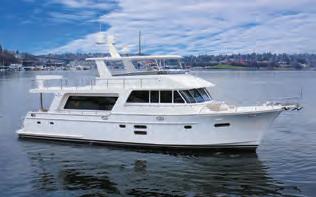
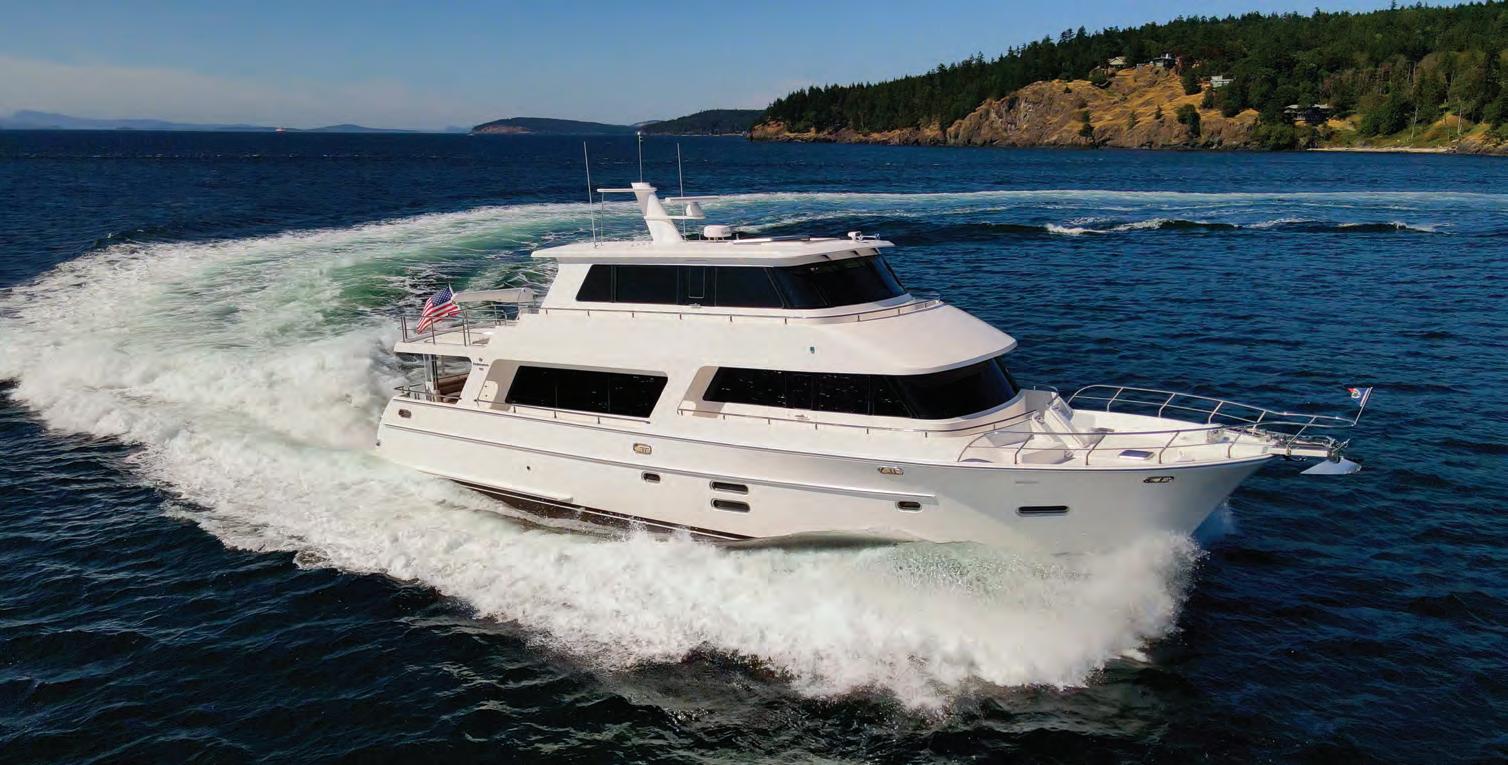



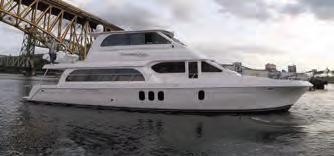







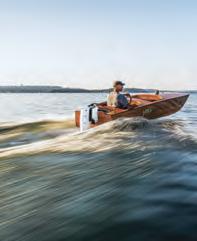
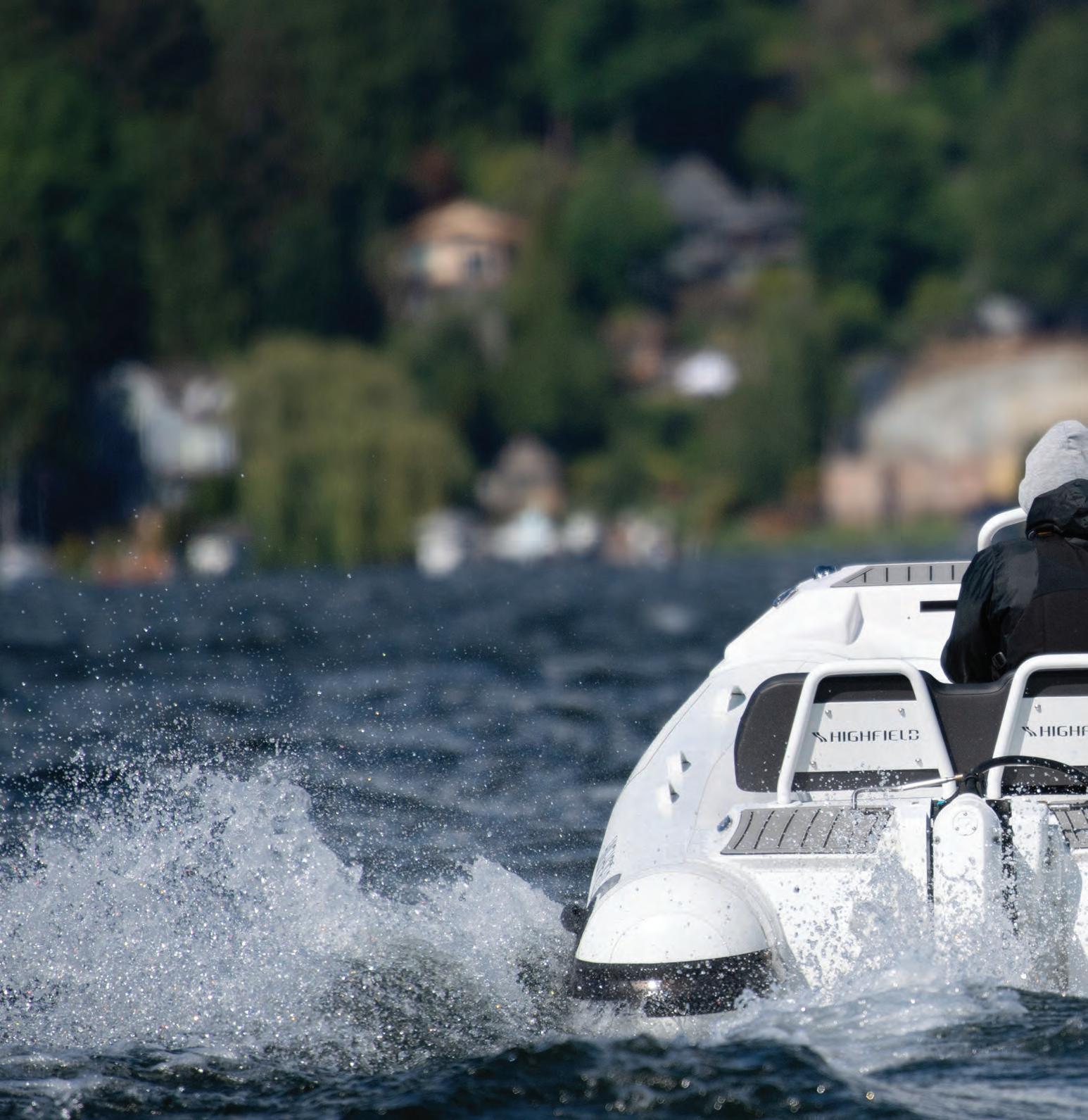

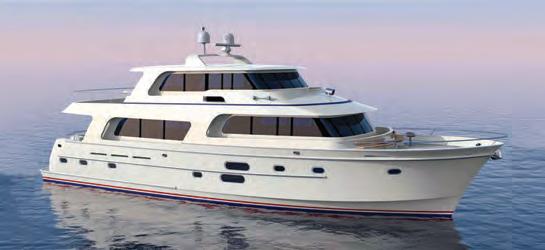

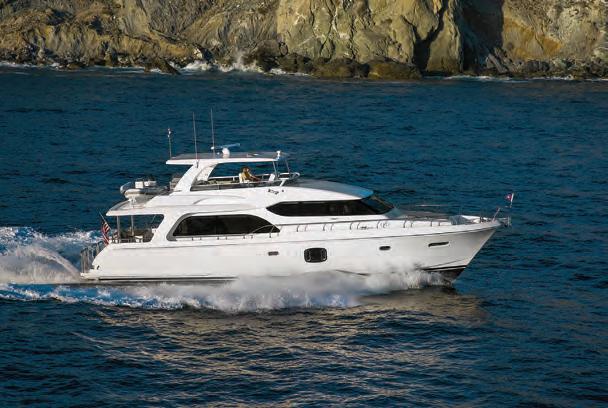

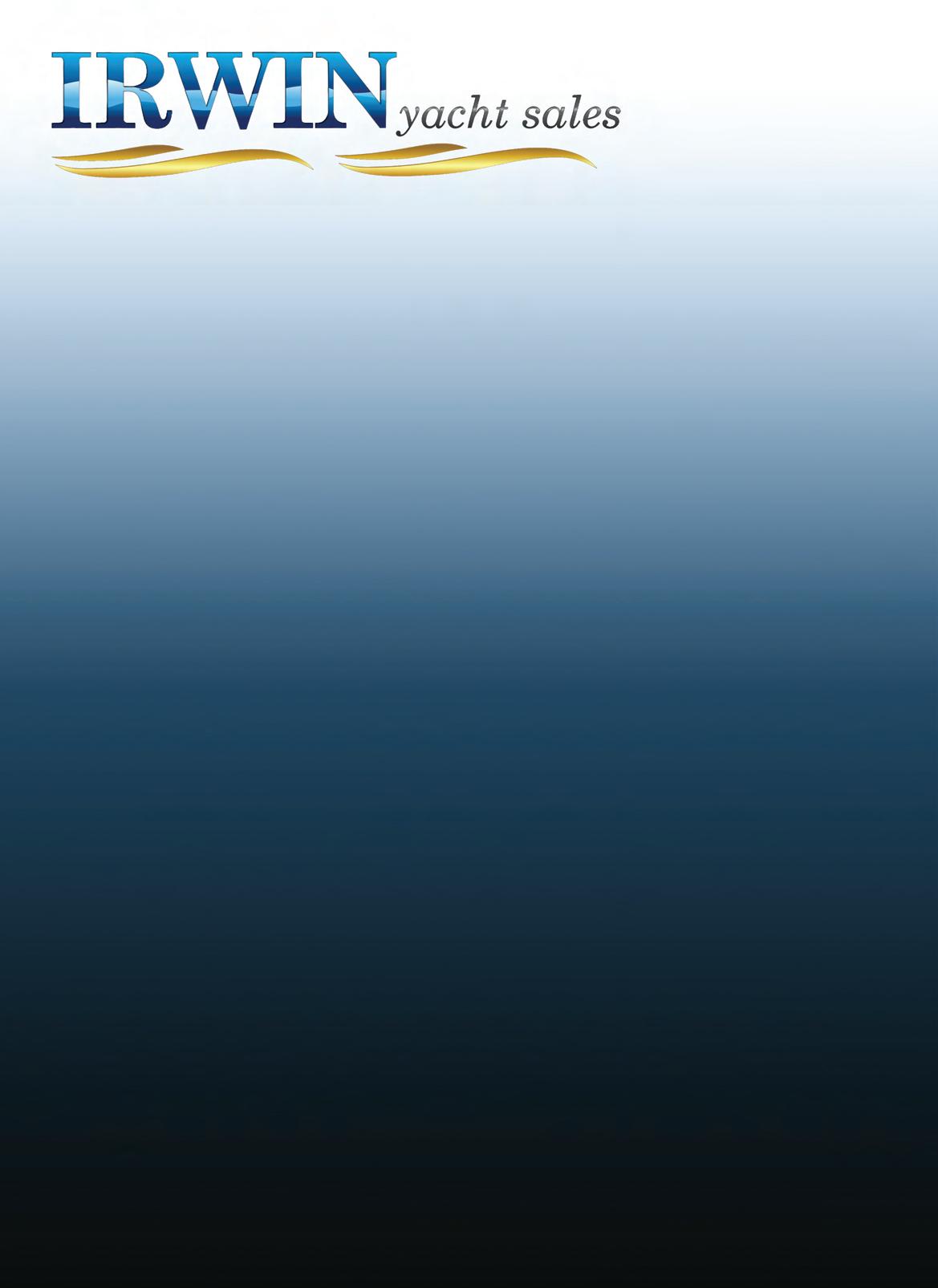







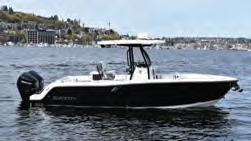

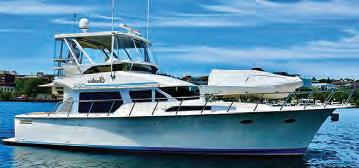


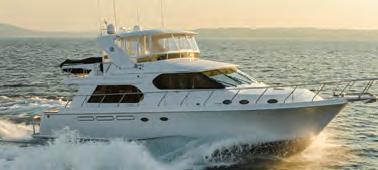

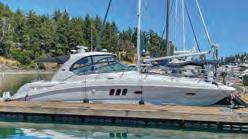


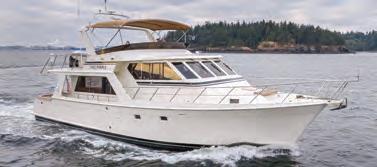
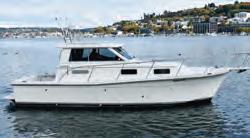
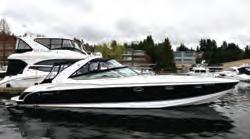


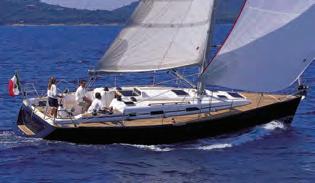

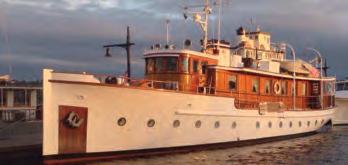
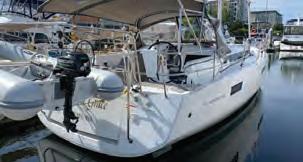

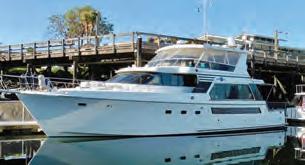


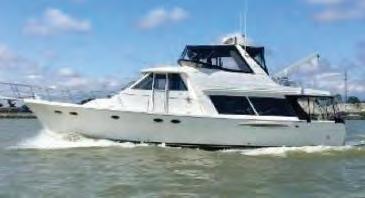
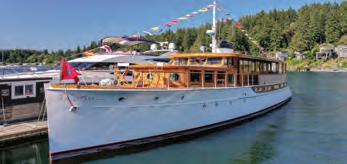
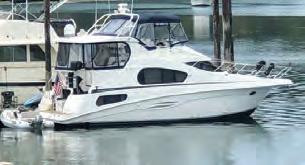
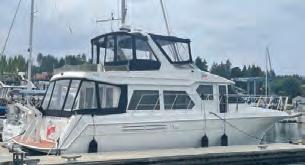
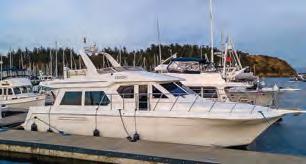



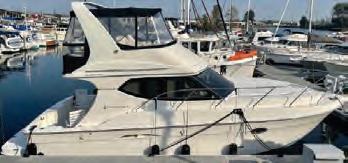



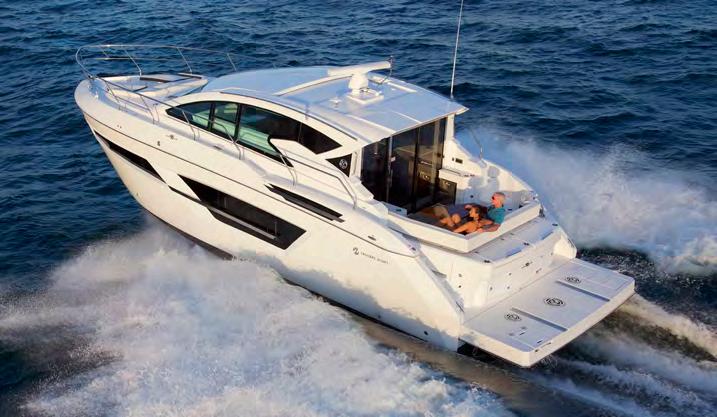
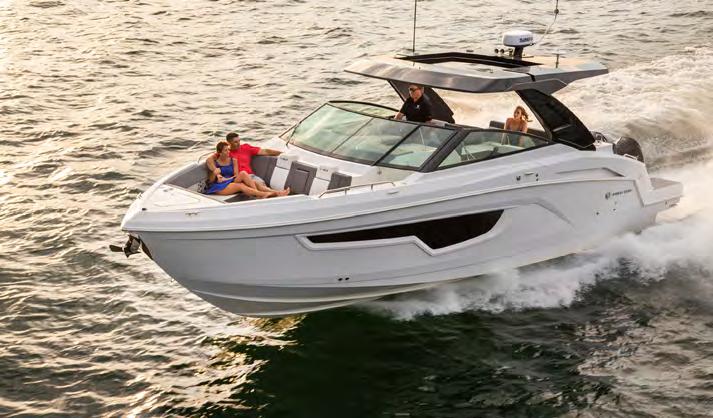







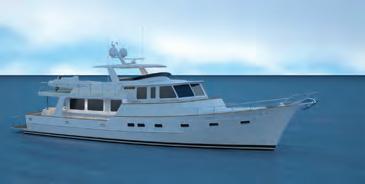
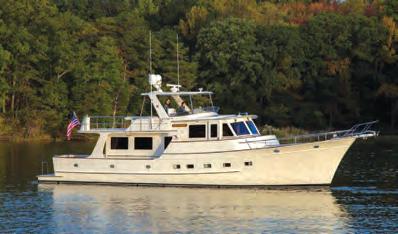
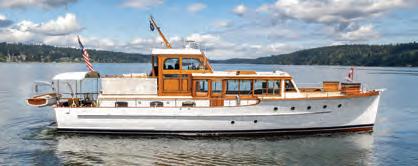


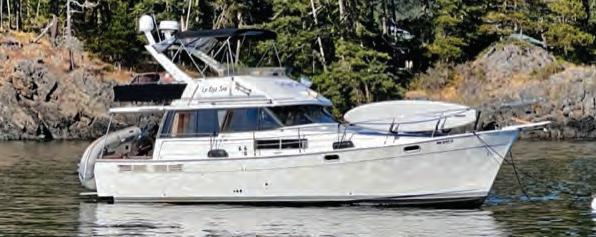
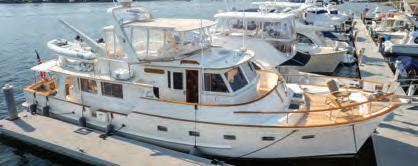
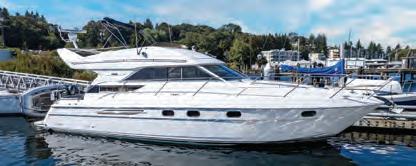


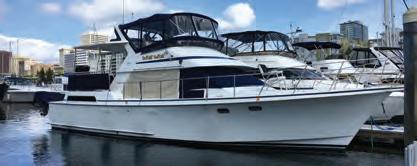
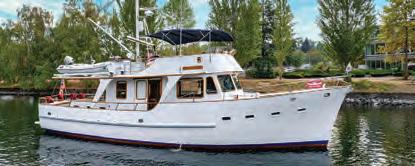

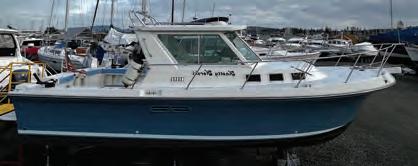
Happy New Year! As we say “ahoy there!” to 2023, I’m feeling especially buoyant because I know, along with many other boaters I would imagine, that a special time of year lies just ahead: It’s boat show season, people!
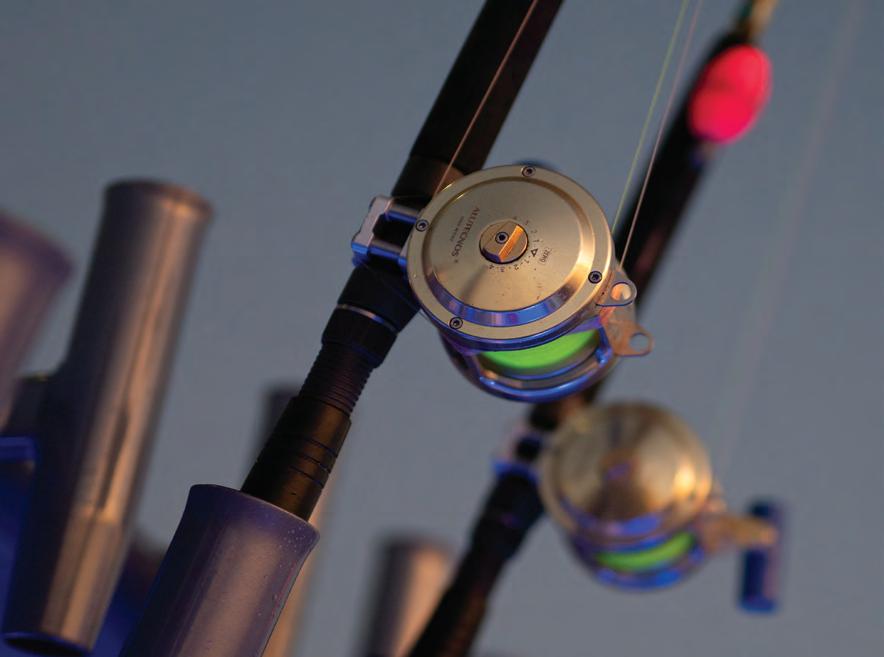
And, as the 76th annual Seattle Boat Show docks at Lumen Field Events Center early next month, we’ve got an issue that is chock-full of special sneak peeks of this year’s event. The team at the Northwest Marine Trade Association has been hard at work all year, boosting the number of new boating-related seminars on offer by a whopping 25 percent—we highlight a boatload of them in this month’s “Welcome to the Show” feature beginning on page 44, and give an inside angle on this year’s fishing seminar topics in Expert Take on pages 62-63.
The New Year is also looking bright for Pure Watercraft, a Seattle-based company known for their stellar electric outboard engines, that will soon expand their offerings thanks to a new partnership with General Motors. Randy Woods hops aboard a zippy RIB ride, and gets inside the tech that powers the enterprise, in his feature on pages 52-59. Also blazing into 2023 are this month’s impressive Broker’s Best finds, which range from a handsome Westcoast 46' from Chuck Hovey Yachts (pages 40-41) to the incredibly speedy and sleek Invincible 37’ catamaran from Schooner Creek Boat Works (pages 36-37). Start your new year with Tight Lines as Mark Yuasa reels in the winter fisheries now open across the state (page 66); James O. Fraioli warms things up with a luscious crab bisque in Sea Fare (pages 76-77); and, in Making Waves, we check in on the Maritime Blue Accelerator program, outline the Port of Seattle’s latest plans, and, of course, preview all the boat shows happening up and down the West Coast (pages 21-26).
Mark your calendars and see you there, Kate Calamusa Editor Say hi: kate@nwyachting.com
CRUISE ALONG WITH US ONLINE: Visit our website at: nwyachting.com facebook.com/NorthwestYachting instagram.com/nwyachting
Publisher & Advertising Sales Michelle Zeasman-Gibbon
Associate Publisher Michelle DeRouen michelled@nwyachting.com 206.445.5453
Editor Kate Calamusa Creative D irector Lou Maxon Advertising D esign Christin Couvreux
Advertising Sales Craig Perry craig@nwyachting.com 206.391.6431

New Advertising Sales Inquiries 206.789.8116
Columnists Lori Eastes James O. Fraioli Doug Hansen Andrew Hoge Randy Woods Mark Yuasa Copy Editor Seanna Browder Facilities Maurice McPherson Office Mascot Pearl General Inquiries: 206.789.8116 Published monthly by SKT Publishers, Inc. 7342 15th Ave. NW, Seattle, WA 98117

As Vulcan’s Lake Union Piers project continues to evolve here in Seattle—which we covered in our November issue and you can still catch online at nwyachting.com—several local yacht brokers are greeting the New Year by coming home to their newly refreshed digs. Swing by and say hi to the fine folks at Worth Avenue Yachts, Hampton Yacht Group, Chuck Hovey Yachts, and others to see the progress in person. Also found at Lake Union Piers: the new offices for Northwest Yacht Brokers Association, which recently announced the hire of Director of Operations Karli Houlé. An extra special “welcome!” to Karli!

The best kind of research: As he delved into the Pure Watercraft feature for this month’s issue (see pages 52-59), writer Randy Woods hopped aboard a RIB outfitted with the Seattle company’s electric outboard engine (and even an extra battery) for a ride around Lake Union. He reflects:
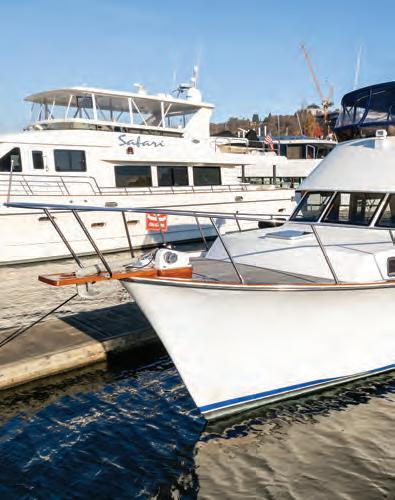

When I met Pure Watercraft marketing manager Gabe Johnson, we had a chat about the use of heavy batteries, even on small vessels like the 12’ RIB we were riding in. “With these rigid inflatables, you can put one in the console and one in the back, so you can have two,” he said. “Adding more packs won’t make you go faster, but it’ll last longer. You can put up to 10 batteries in a series if you want.” You’d never know the boat was carrying more than one battery pack the way were zipping around, almost silently and with the sweet absence of any engine exhaust.
While perusing the pics of Spirit So Moves, a 2004 Westcoast 46 from Chuck Hovey Yachts, for this month’s Broker’s Best feature found on pages 40-41, we noticed a familiar silhouette in the background. It was none other than Safari, the sleek 80’ Symbol pilothouse from Worth Avenue Yachts you’ll find on a preceding spread (pages 38-39, to be exact). It made us smile to realize these amazing offerings are not only pals in our pages, but in real life, too!
















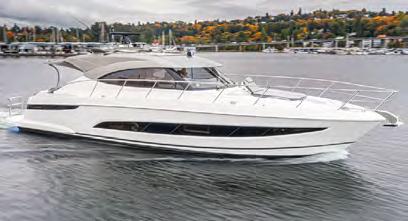



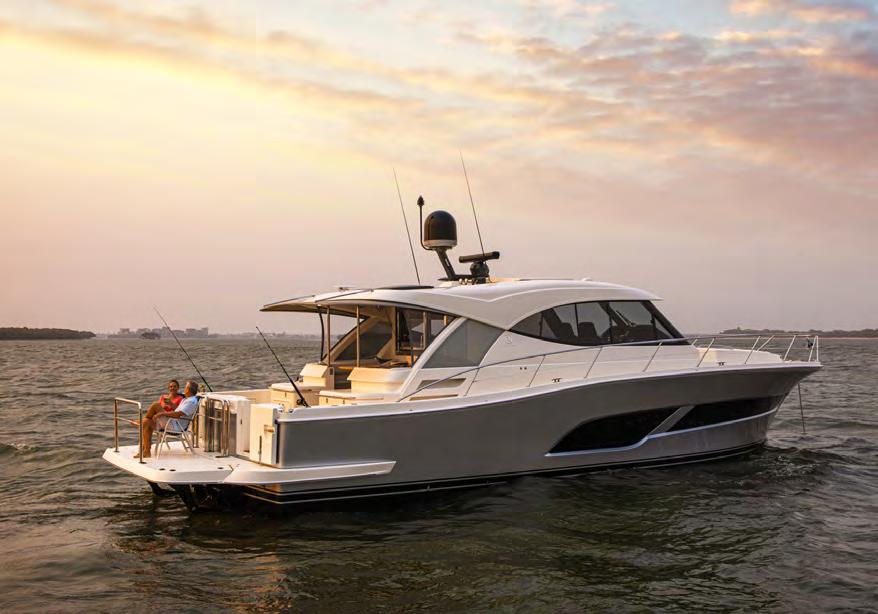
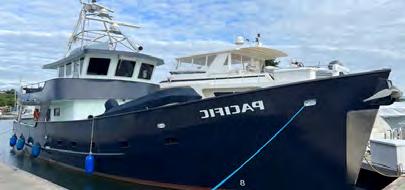





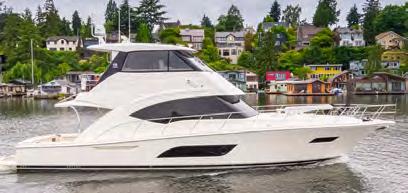
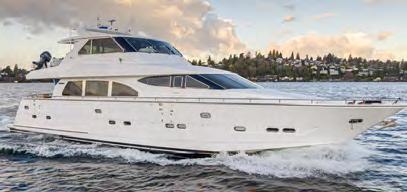

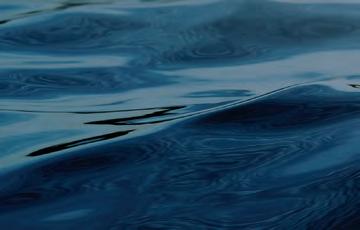

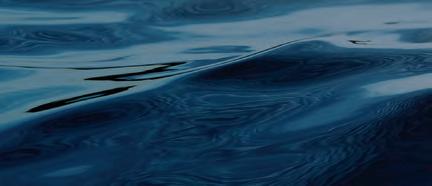
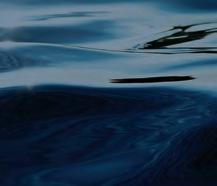




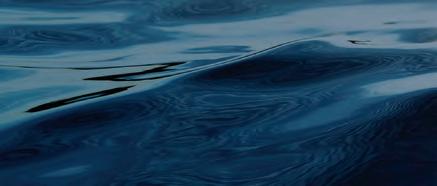
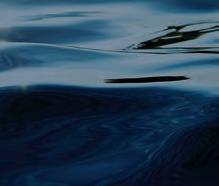




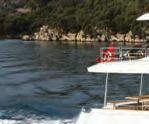







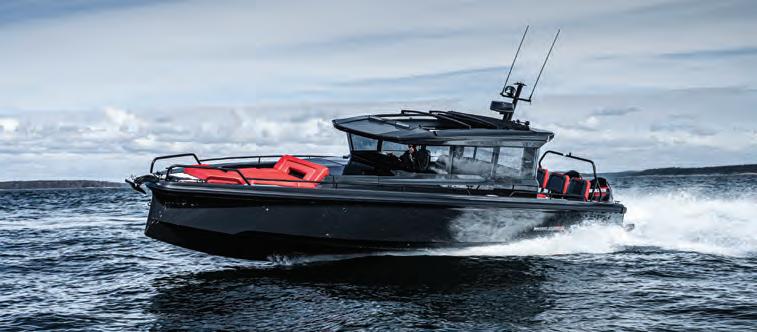










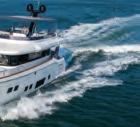

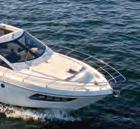
 BY RANDY WOODS
BY RANDY WOODS

With the start of a fresh new year, the Northwest maritime community is gearing up for a return to full-scale boating shows after years of false starts and reboots. The first one, the Portland Boat Show, launches this month (January 11-15), followed by the Vancouver International Boat Show (February 1-5) and of course, the Seattle Boat Show (February 3-11).

In Portland, the premier boat show for Oregon and Southwest Washington will kick off the 2023 season—the 63rd in its history—with more than 200,000 square feet of exhibit space at the Portland Expo Center, the perfect place to enjoy the Rose City while avoiding the winter chill and damp. As one of the largest sportfishing expos in the nation, Portland will feature hundreds of the latest models of ski boats, wakeboards, pontoon boats, cruisers, runabouts, and personal watercraft.

With such an early start in the season, the Portland show is a great venue to get the first glimpse on this year’s new lines and accessories, along with power options and upgrades. Some of the expected highlights include the new 34’ Jeanneau NC 1095 Flybridge from Sundance Yachts; the latest Lund Boats from Pacific Boatland; KEM Equipment’s new LT4 and LSX inboard engines; River City Ravine’s popular Bennington pontoon boats; Torch Craft Marine’s mini-jet-boats; and Schooner Creek’s 37’ Invincible catamaran with quadruple Mercury Verado outboards (see this month’s Broker’s Best on pages 36-37 for more on this beauty); plus, the latest trends in electric e-foil boards, and much more.
This year will also feature a pre-owned boat sale, for those interested in the best deals for slightly older models. A two-for-one discount offering $15 off of parking prices can also be found at the Portland show’s website: pdxboatshow.com


Up in Canada, excitement is building for the first in-person Vancouver International Boat Show since a three-year Covid hiatus. The 2023 show—to be held indoors at BC Place and on the water at Granville Island—will feature more than 200 exhibitors

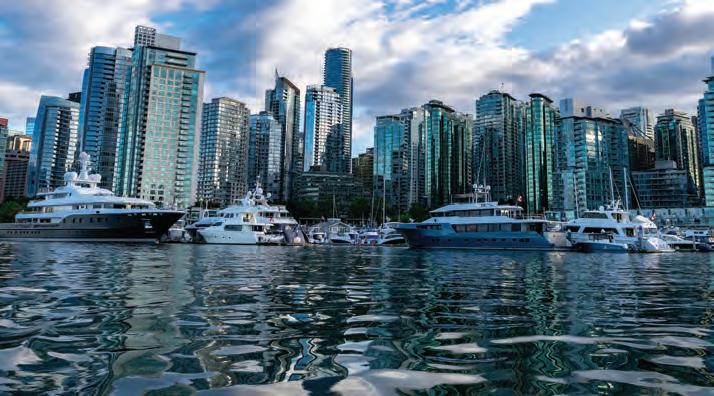
offering hundreds of their latest boats and marine gear, plus dozens of informative seminars.



Topics of the sessions include a wide range of boating issues: marine electronics tips, vessel maintenance and repair, environmental stewardship, boating safety advice, sailing as a family, and real-life stories of global ocean cruises. One emphasis in the Vancouver Show seminars will be information for boating newbies. In a series sponsored by Canada’s National Marine Manufacturers Association and called Discover Boating, the Boat Show will provide information for those seeking tips about first-time boat purchases, working with dealers, insurance advice, and navigational basics. More can be found at: vancouverboatshow.ca
The Seattle Boat Show, organized by the Northwest Marina Trade Association and presented in partnership with Union Marine and the Port of Seattle, is the largest boat show on the West Coast, spanning nine full days, and will be held at Lumen Field Event Center and Bell Harbor Marina. A free shuttle will run continuously between both locations.
The show floor, measuring three acres, will showcase some of the latest marine gadgets and gear. The event will also include its popular Boat Show U sessions and an extensive list of boating and fishing seminars, many of which will be new this year and focus on technology and innovation (see this month’s feature on pages 44-51 for more details). For entertainment, the Seattle show will host wine and beer nights, a “Dogs on Deck” day which allows your pooch to stroll the aisles with you, and a Kids AquaZone full of family-friendly activities.
Seminar tickets include access to all online and in-person webinars, a 2023 Waggoner Cruising Guide, and multi-day tickets for the full nine-day show. For more specific details about hours, exhibitors, and attractions, go to: seattleboatshow.com.
Seattle always has focused on the maritime economy, and at the end of November 2022, the Port of Seattle Commission backed up this commitment with an ambitious budget for 2023 and a $5.3 billion five-year capital plan, the largest in the Port’s history.

While most of the funds will be dedicated to improvements and expansion of SeaTac Airport, a significant portion will go towards programs to reduce greenhouse-gas (GHG) emissions from maritime vessels, including cargo ships and cruise ships operating out of Seattle and Tacoma.
The Port’s total capital budget for 2023 is $725.8 million. The 2023 budget, approved by the Commission on November 29, will have operating revenues more than 24% higher than the 2022 budget, total expenses nearly 15% above 2022 levels, and net operating income a whopping 42% above the previous year.
“Our maritime budget includes support for research and conservation— from kelp to killer whales—because protecting our marine environment provides competitive advantages for our maritime tenants,” said Fred Felleman, one of the Port’s commissioners.
The budget plan will invest $276.4 million in the marine terminal modernization and environmental sustainability projects, according to Sam Cho, another Port commissioner. “This budget also funds the completion of Seattle’s Terminal 5, the only new cargo container terminal to open on the West Coast during the course of the pandemic,” Cho said.
In 2023, capital spending will make up 39% of the Port’s budget, and up to 43.5% including projects that are part of the Northwest Seaport Alliance, a coalition of marine cargo operators in Seattle and Tacoma. The proposed 2023 budget also includes $17.7 million for environmental initiatives and $11.9 million for customer experience initiatives. Some of the maritimerelated highlights of the 2023 Port budget include:
• $1 million for the Port’s Aquarium Strategic Relationship for maritime industries and habitat conservation education.
• $200,000 to explore maritime economic development opportunities in the offshore wind industry.
• $200,000 to support exploration of a Green Corridor between Alaska, British Columbia, and Washington, in which cruise ships would pledge to operate using low GHG-emitting vessels.
“In periods of change, those who can adapt quickly fare best,” said Ryan Calkins, president of the Port of Seattle Commission. “Because of the vital role the Port plays in our local economy, we need to continue to make major strides on transformative initiatives like decarbonizing port-related industries.” For more on the Port’s future plans, go to: portseattle.org








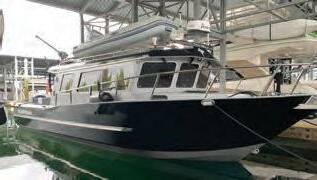


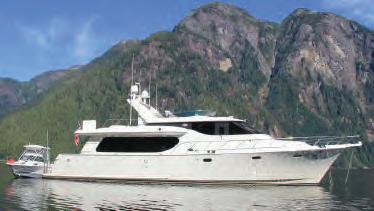
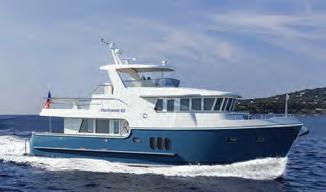

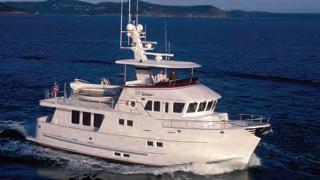

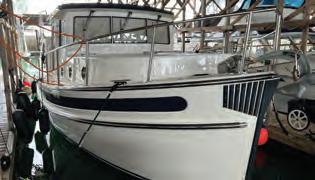
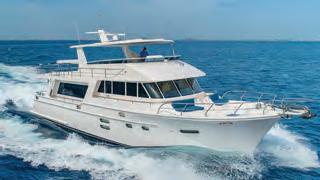

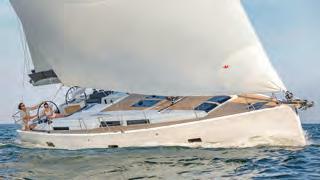
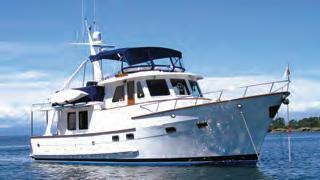







 BY RANDY WOODS
BY RANDY WOODS
Washington Maritime Blue, a statewide coalition of businesses promoting the maritime industry, is poised to begin what looks to be a banner year with the creation of the new One Ocean Innovations Accelerator, as well as the expansion of two other regional initiatives in Tacoma and Seattle to create more interest in marine-related startups and careers.
The One Ocean accelerator is a 12-week course focused on international maritime startups that will help expand Washington’s ocean economy. The program allows qualified startups to receive resources, contact mentors to aid in business development, and attract potential investors to get their ideas off the ground.
The first eight weeks of the program will be conducted through virtual instruction and will be mostly concerned with matchmaking startups with the right personnel and analysis of the regional markets. The second stage of the process entails one-on-one mentoring of entrepreneurs with other experts in the particular startup’s field. Companies will give presentations of their business plans and receive advice on building their venture’s business ecosystem.
The final stage of the incubator will be a showcase day, where startups will make polished presentations before potential investors. If any of the startups attain investment, One Ocean will continue working with them to assist in market entry for the businesses. Some of the expected entrepreneurs in the One Ocean Accelerator will focus on maritime decarbonization, port and shipping logistics, digitalization of maritime operations, renewable energy, sustainable fishing, and advanced manufacturing.
In the South Sound, the Tacoma Marine Innovations Incubator, based out of the Center for Urban Waters, expanded with its Second Wave of cohorts in October 2022. Companies came from Washington state, California, and France. Locally based cohort firms include:
• Air Mobility (Tacoma) – A marine propulsion company specializing in bladeless powering technology.
• Homeostasis (Tacoma) – A carbon dioxide removal and utilization startup aiming to convert CO2 emissions into raw materials, such as graphite and carbon black, for industrial applications
• WhyGrene (Seattle) – A startup that creates “virtual power plants” that provide affordable, green energy for utility power grids.
Meanwhile, at the end of last year, the affiliated Washington Maritime Blue Accelerator program was entering the final stages of choosing new cohorts for its Fourth Wave. The 2023 program is slated to begin in late February, when the next cohort will be announced.
The blue economy is estimated to be worth about $373 billion nationwide, to which Washington state contributes roughly $44 billion. The local blue economy also has ties with other regional sectors, including aerospace, agriculture, clean technology, and life sciences.
For more on all of Washington Maritime Blue’s current initiatives and programs, go to: maritimeblue.org

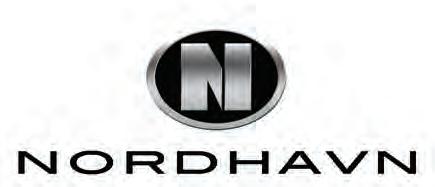


The City Loo’s chic new canine commode offers a convenient (and attractive) on-the-go solution for your favorite first mate.


You’ve carted in your provisions, checked all your gauges, and idled away from the dock…. only to realize that you forgot to offer your furry first mate a pre-voyage sniff around the fire hydrant. Enter the City Loo, an all-in-one puppy pad bathroom system that aims to cut down on onshore stops and keeps you cruising in style. Although she conceived her first prototype for urban-dwelling dogs to utilize in condos or apartments between walks (and to aid their humans in avoiding damp, dark nighttime treks around the block), CityLoo founder Anastasia Miles realized there might be an untapped market for her product after a visit to the Fort Lauderdale International Boat Show in 2021. Brokers and boaters there clamored for it, and it’s little wonder why: Crafted from medium-density fiberboard with clear acrylic walls, stainless steel hinges, and an interchangeable dog door entrance, the sleek system is perfect for placement on the aft deck or in the salon, measuring a compact 21” high by 29” wide and 21” deep. Owners can pop in their own turf or absorbent pads or snap up some of City Loo’s selection of add-on options, which include a high-grade odor absorbent tray. “As someone who loves boating and my dog, Coco; I think this is a game-changing solution,” says Miles. “It’s convenient, looks great, and it’ll keep you out on the water for longer, too.” The City Loo retails for $299; more details and product information can be found at: thecityloo.com.
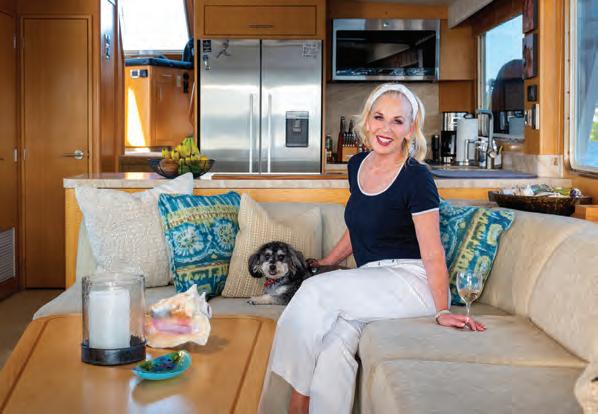
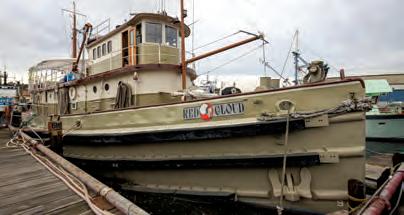

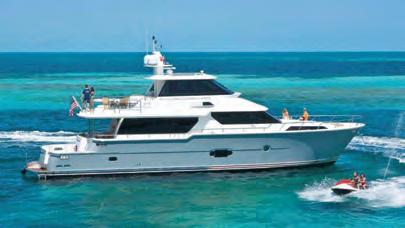

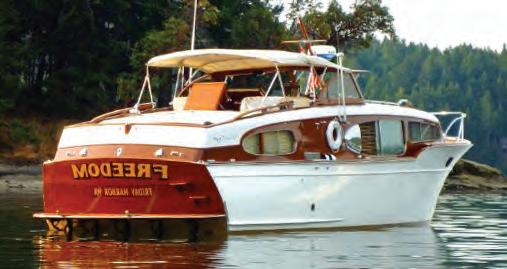
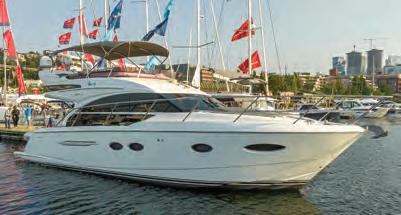
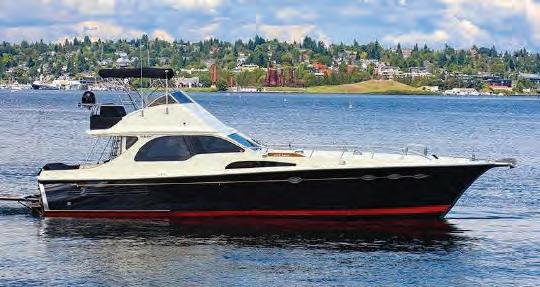
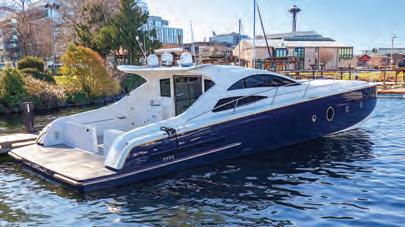
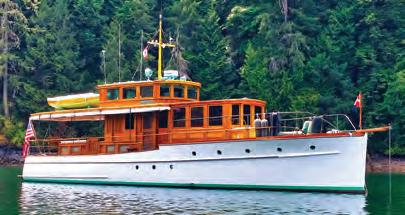
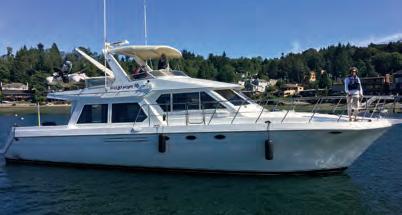

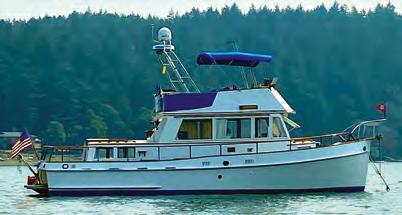



 100’ US NAVY TUG 1943 - Converted to live-aboard, steel hull, sleeps 8 guests / 3 crew, 2 galleys, Enterprise main, 3 generators. Contact Dan Wood.
83’ BURGER 1967 - Once in a lifetime special vessel, kept in state of the art boathouse, cared for by knowledgeable yachtsman, fresh paint. Contact Dan Wood.
74’ HORIZON V74 2011 - Enclosed bridge, 3 staterooms plus crew, captain-maintained, boat is painted, CAT power, 20’ 6” beam. Contact Dan Wood.
36’ GRAND BANKS CLASSIC 1973 - Lots of upgrades, always well maintained, extremely clean, recently cruised for 75 days, must see! Vic Parcells.
48’ HATTERAS MOTORYACHT 1981 - Live aboard moorage available, 3 staterooms, huge aft stateroom & aft deck, 6V92 mains, new generator, fresh water kept. Contact Dan Wood.
36’ CHRIS-CRAFT CORVETTE 1954 - Restored, all-original, a joy to run. Everything works, true head-turner, just gorgeous. Contact Vic Parcells.
100’ US NAVY TUG 1943 - Converted to live-aboard, steel hull, sleeps 8 guests / 3 crew, 2 galleys, Enterprise main, 3 generators. Contact Dan Wood.
83’ BURGER 1967 - Once in a lifetime special vessel, kept in state of the art boathouse, cared for by knowledgeable yachtsman, fresh paint. Contact Dan Wood.
74’ HORIZON V74 2011 - Enclosed bridge, 3 staterooms plus crew, captain-maintained, boat is painted, CAT power, 20’ 6” beam. Contact Dan Wood.
36’ GRAND BANKS CLASSIC 1973 - Lots of upgrades, always well maintained, extremely clean, recently cruised for 75 days, must see! Vic Parcells.
48’ HATTERAS MOTORYACHT 1981 - Live aboard moorage available, 3 staterooms, huge aft stateroom & aft deck, 6V92 mains, new generator, fresh water kept. Contact Dan Wood.
36’ CHRIS-CRAFT CORVETTE 1954 - Restored, all-original, a joy to run. Everything works, true head-turner, just gorgeous. Contact Vic Parcells.
HIGHFIELD BOATS ARE THE #1 RIB IN NORTH AMERICA, AND THEIR GOOD LOOKS ARE AT HOME VIRTUALLY ANYWHERE.
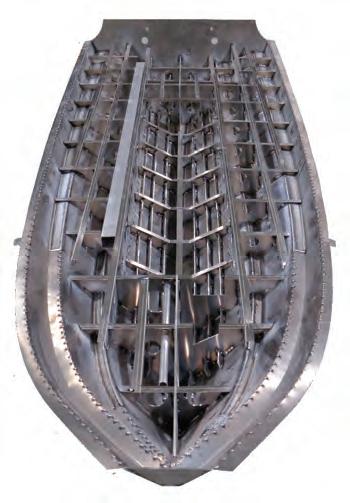
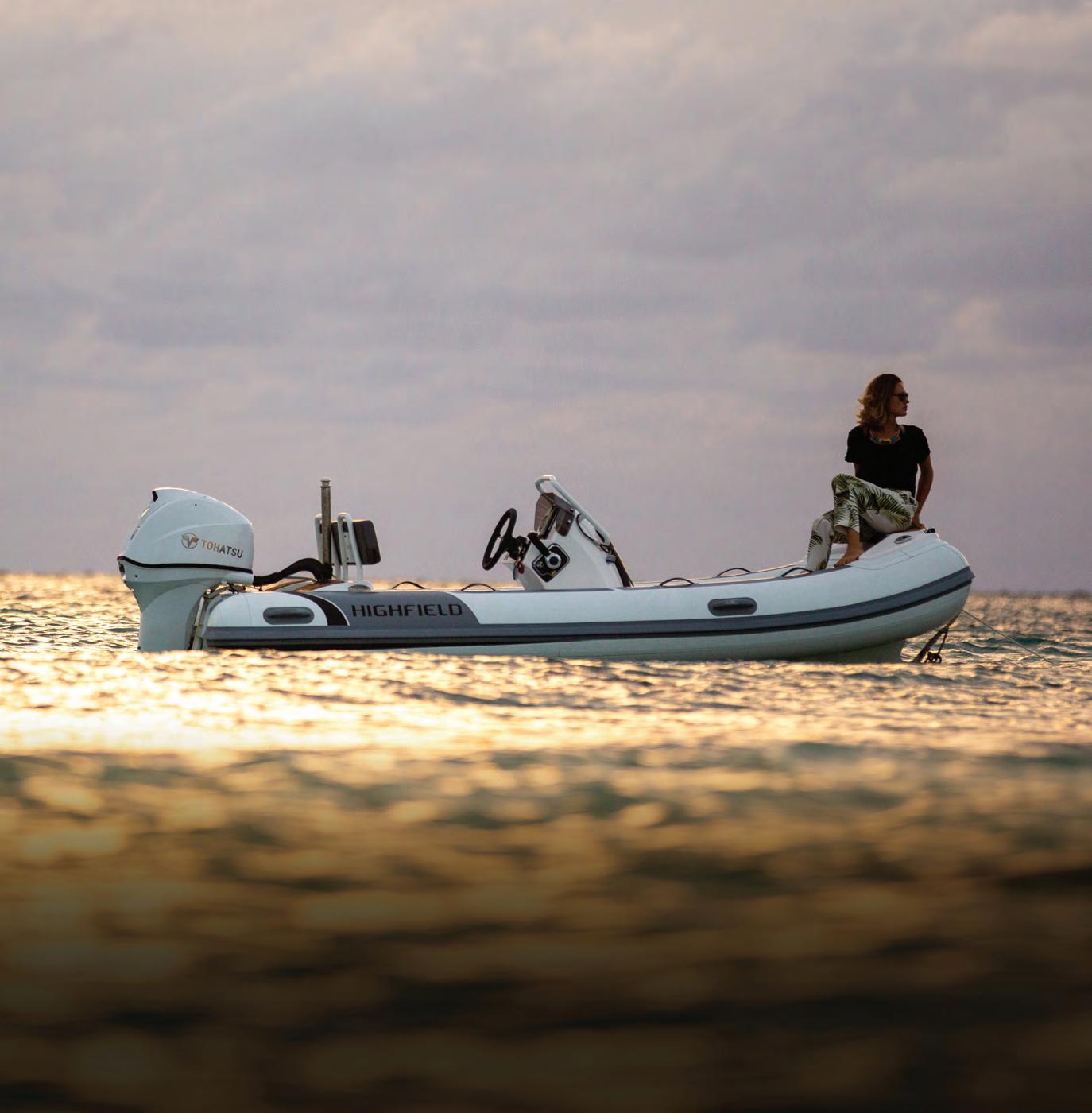
Which is fortunate, because we also build them to take you pretty much everywhere. Every hull is made from high-tensile, marine grade aluminum and is over-built and tested to excel in the planet’s toughest conditions. It’s why we’re #1, and why you’ll have the confidence going places others simply can’t.
highfieldnorthamerica.com









Never be out of contact on your coastal excursions with Garmin’s new inReach Messenger satellite communicator. An active satellite subscription is all you need to maintain global two-way messaging, interactive SOS, and constant connection with friends and family, even outside of cell coverage. The inReach also provides weather updates and lets you share your GPS location, texts, and group messaging via Garmin’s Messenger smartphone app. The unit switches seamlessly between Wi-Fi and global Iridium satellite networks, ensuring you always get the most cost-effective connections. The inReach can also be networked with other Garmin handhelds, marine equipment, wearables, or other smart devices.
$300 // Available from Fisheries Supply in Seattle, fisheriessupply.com

Defeat the damp with the new Lowlands indoor/ outdoor water-resistant travel blanket by YETI. The tough outer layer provides ultra softness on one side and a waterproof shell on the other, allowing you to relax on deck or in your cozy cabin. The machine-washable camping blanket is insulated for the chilly winter nights and comes with three-year limited warranty. Salty dogs are welcome, too—the Lowlands blanket is made with blended polyester and rayon material that repels dirt and pet hair, so Fido can snuggle right on up beside you. Available in purple, yellow, pink, and blue colorways, and includes a zippered carrying case. $200 // yeti.com
With this sturdy BlackTip tool kit, anglers have everything they need close at hand before the big one bites. For all of your cutting needs, the zippered case features a 2.5” bait knife and a 6” fillet knife, both of which are made using nonstick 420J2 Japanese steel. An 8.75” marine shear includes a serrated edge for descaling and an integrated bottle opener, with handles that come apart for easy cleaning. The 8.5” dehooker is made with aluminum and stainless steel, and the 37” tape measure makes sure you can brag about that three-footer you caught and back it up with evidence. All tools come with molded, ergonomic grips for a sure hold every time. $77 // Available at West Marine stores, westmarine.com
 [ SMART GADGETS AND STYLISH PRODUCTS THAT REALLY FLOAT OUR BOAT ]
[ SMART GADGETS AND STYLISH PRODUCTS THAT REALLY FLOAT OUR BOAT ]


Few fishing-gear items are as tough as classic shoreman’s bibs and pants, used to keep the hard workers free of fish guts after the nets are hauled in. When it’s time to make new ones, why waste the scrap material? European clothier Grundéns is now upcycling bib and apron scraps from its cutting-room floor to create this handy Shoreman Tote Bag. Made of the same double-coated, PVC/PU-blend fabric used in the company’s indestructible aprons and pants, these water-resistant totes include an external storage pocket, an internal zippered pocket for added protection of valuables, and strong nylon webbing for handles. $37.49 // grundens.com
Make sure your next little overboard accident doesn’t lead to new phone purchases or canceled credit cards. This 10.6- by 5.4- by 2.4-inch Pelican G40 Personal Utility Go Case has an IP67 waterproof rating and is large enough to fit most cell phones (up to iPhone Xs Max and Samsung Note 9), along with a divider tray for credit cards, USB cables, jewelry, and many other small valuables you want to keep safe. Equipped with an impact-resistant ABS outer shell, the Go Case is also crushproof and dustproof, thanks to a built-in valve to balance interior air pressure. It all comes with a rubber protective bumper around the edges to handle sudden drops on hard decks, as well as a lifetime guarantee. $44.95 // pelican.com

They may look like ordinary sneaks, but these Astral Brewer 2.0 shoes are actually super sailors. With breathable Airmesh canvas uppers, front and rear drainage vents in the EVA midsoles, and razor-siped, non-marking rubber outsoles, this new men’s footwear from REI is built for a winter’s day on board. Precisely balanced to place the heel and ball of your feet on the same level, the Astral Brewer gives you the balance and agility you need for keeping a firm grip on pitching and rolling decks. A step-down heel makes quick removal a snap, while built-in sock liners and soft foam provide unparalleled comfort. Available in three colors. $115 // rei.com

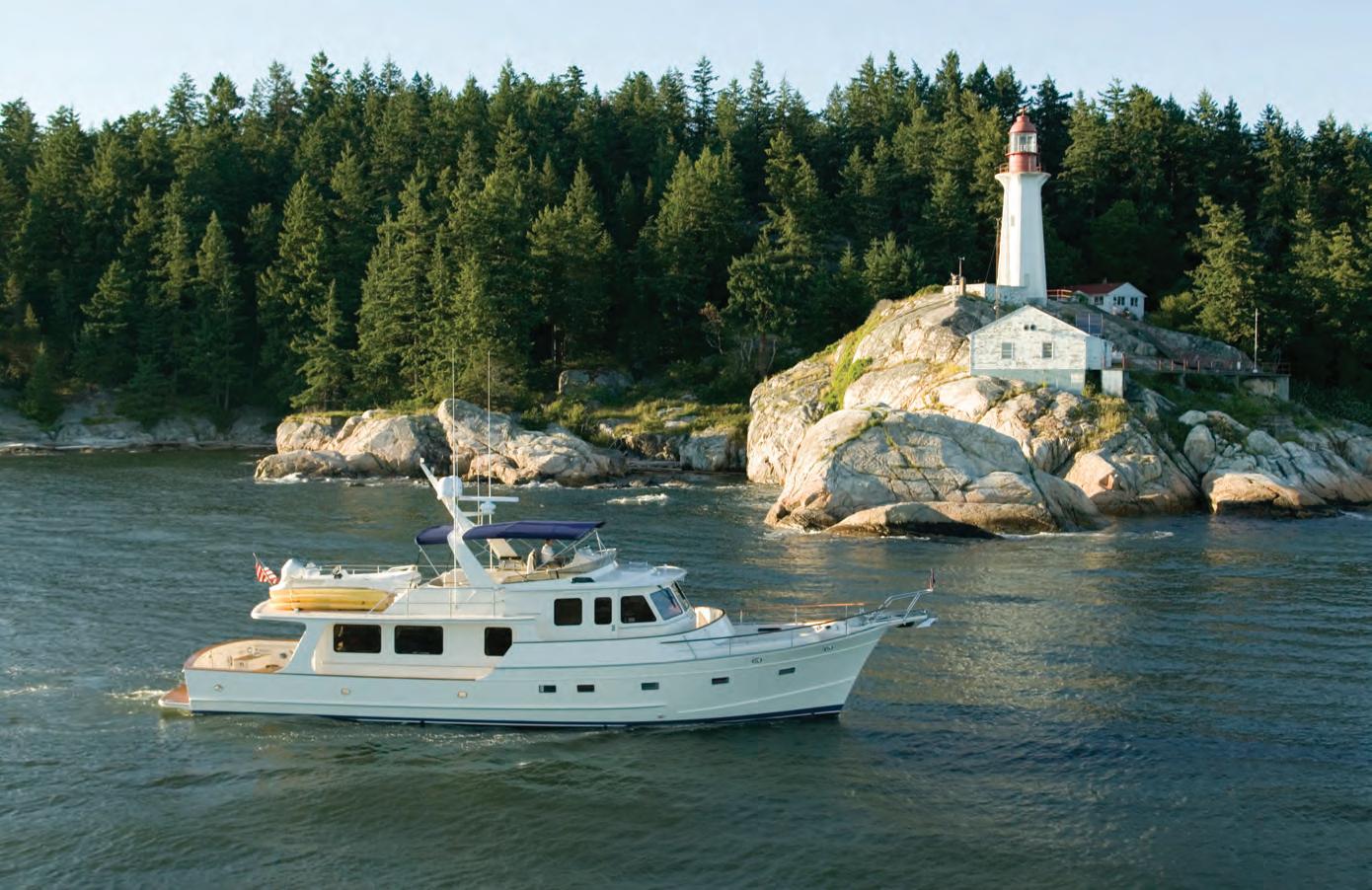
Get out on the water in comfort and style. The Apollonian 52 is designed and built to be easily handled by a couple and comes fully equipped to cruise. The pilothouse door and wide side decks provide convenient access, and the 52’ overall length fits most 50’ slips. Apollonian Yachts delivers quality craftsmanship, advanced construction, and abundant accommodations in a new boat priced to compete.






Sure to be one of the stars of this month’s Portland Boat Show, this 2022 Invincible 37', on offer from Schooner Creek Boat Works, has never been sailed and still has that lovely “new catamaran” smell. The 37' cat is a spacious center-console open fishing boat with beefy quad outboard engines—this one has four 300hp Mercury Verados, with top speed in excess of 75 mph, but there is room for Mercury 450s should you wish for an even bigger kick. Envisioned by the iconic Morrelli & Melvin Design & Engineering firm, this Invincible cat features the team’s semi-asymmetric, twin-hull template, giving the boat exceptional handling and nimble turning without negative trim. The 360-degree, walk-around layout, roomy 12’ beam, and 600 nautical mile range make it ideal for extended fishing excursions and has many amenities for the seasoned angler. With Seachest livewells above and belowdecks, the 37' cat includes
Speedy and sleek, this 37' Cat available from Schooner Creek Boat Works is a twin-hulled, twin-stepped fishing machine.
bait prep and tackle stations, a fiberglass cooler with a sliding track system, and a whopping 20-plus rod holders on virtually every flat surface on the gunwales and console. Two side doors make it easier to reel in big tuna or marlins over the gunwales, where they can be stored in four fish boxes under the main deck or in the large coffin box forward of the console. At the helm, the boat is operated from triple custom Llebroc chairs with a built-in cooler and another set of back-to-back, aft-facing chairs. Twin 22” Garmin touchscreens provide clear visuals of all boat systems, which also has dual Icom radios, Mercury VesselView, and autopilot. The T-top housing around the helm includes an acrylic windshield on three sides to protect from the elements.

The many seating areas include a U-shaped bench around the squarish bow, fold-out backrests, and two fold-down jump seats in the cockpit transom.
The extended coffin box is also topped with cushioned sun pads with removable backrests for additional passenger seating or lounging. A JL Audio sound system provides tunes to the 14 speakers on board. Directly under the helm console is a deluxe electric head. For watersports activity, there is a dive door off the wide cockpit with a pull-out dive ladder, as well as a second pull-out ladder in the transom, located between the center outboards.



For more than 20 years, this 80’ Symbol Pilothouse yacht has been meticulously maintained and upgraded by its current owner, a knowledgeable yachtsman. Well-suited for entertaining guests and extended cruises, Safari features three spacious staterooms and luxury accommodations for up to six guests, plus room for three crew members.
Built in 2002, this large Symbol motoryacht is driven by twin Detroit Diesel 2000 MTU engines, each producing 915 HP and logging about 5,500 hours of use. The walk-around teak decks provide easy access to both the open-air bow section, with a sunpad and bimini, to the spacious aft-deck, anchored by a teak dining table, with upholstered Luxe Ingigo bench seating and four wicker swivel chairs. Two glass doors separate the aft deck from the salon, featuring an enormous distressed-leather sofa, two library chairs, a 36” live-edge wood cross-section coffee table, and a 48” smart TV within a built-in TV cabinet.
Forward of the salon, the port-side galley boasts a wrap-around granite countertop, a KitchenAid refrigerator/freezer, a double sink with disposal, and an Insta-Hot water tap. GE appliances include a convection/ microwave and a five-burner cooktop. The galley opens to the pilothouse, which has a glass table with bench seating, and access to a day head. The helm station has a full suite of electronics and navigation equipment, such as Furuno NavNet 14” TZT display and autopilot, Icom VHF, Wesmar stabilizer controls, and a Maretron display.
Safari has multiple 32” smart TVs installed in the owner’s suite, the flybridge, and the crew cabins, equipped with Dish TV receivers. The sound system consists of five Fusion receivers in the salon with speakers in the salon, aft deck, pilothouse, flybridge, and bow. Other communications equipment includes Iridium satellite phones and KVH satellite internet.
The customized flybridge has a hardtop, a three-quarters enclosure, two Stidd captain’s chairs, and another driving helm station that was updated in a 2015-16 rebuild. For more entertaining, the flybridge has a dining table, seating for eight people, a Wolf two-burner cooktop, a 30” DCS propane BBQ, a 20-bottle wine cooler, and four teak loungers.
Belowdecks, the owner’s suite features lush wood paneling, a full-beam king-size bed, a port-side vanity, a walk-in closet, and a starboard-side settee. The en suite double head has twin sinks and a shower enclosure. The VIP stateroom at the bow has a raised queen-size bed, a walk-in closet, and an en suite head and shower enclosure. The midship guest stateroom includes a raised double bed, access to a forward head and shower, and a washer and dryer.

Over the last seven years, Safari has had multiple rounds of upgrades, replacing and repairing virtually every electronic and mechanical system. Other major installations include a new bulbous bow, a new SidePower hydraulic stern thruster, teak decking and interior carpeting throughout, and new drive shafts, props, and struts.
LOA 80’0” Beam 21’6” Draft 5’6”
Tankage (Fuel/Fresh/Black) 1,600 gal. / 400 gal. / 150 gal.
Two Detroit Diesel MTU 8V2000s
Contact Worth Avenue Yachts Seattle, WA 206.209.1920 team@worthavenueyachts.com worthavenueyachts.com

Chuck Hovey Yachts presents you with a proven winner— this handsome, lovingly cared for Westcoast 46' that plied Northwest waters for almost 20 years.
This sturdy and handsome cruiser was built in Port Coquitlam, British Columbia, and originally designed by Ed Monk Jr. for use in the Tollycraft 43 Tri-Cabin series before Forbes Cooper reconfigured the design for Westcoast. With loving care from the current owner, Spirit So Moves has cruised for years along the West Coast, with 1,900 hours on its twin Cummins 6BTA5, 270hp engines. The Westcoast 46' cruises at 16 knots and can go flat out at 20 knots. With two staterooms and two heads, the layout allows for generous living space and three separate outside decks. The full walk-around side decks are made of teak and are flush to the aft deck. Port and starboard sliding doors allow easy access to the main salon. Inside the carpeted salon is an L-shaped settee with a hi-lo table and an entertainment center with TV, DVD player, and stereo system. A granite-top breakfast bar features two bar stools and an icemaker. The L-shaped settee also folds out to sleep two people.
The main helm to starboard includes hydraulic steering, Morse clutch and throttle controls, full instrumentation, engine-hour meters, a compass, and windshield wipers. Forward and down three steps from the helm you’ll find the U-shaped galley, with granite countertops, a double stainless steel sink, a Norcold refrigerator/freezer, a three-burner electric cooktop, and a convection/microwave oven.

Aft of the salon, a staircase leads to the boat deck and flybridge, which comes with a full canvas enclosure. Flybridge settees, arranged in L-shape, wrap around an adjustable, triangular dining/coffee table that’s near a Magnum BBQ and a Nova Kool mini fridge/freezer. The upper helm station has Icom VHF radio, main engine and windlass controls, a Com Nav autopilot, GPSMAP 1020 series, Bennet trim tab controls, a Sirius XM weather and radio antenna, Garmin radar, a Fusion 650 stereo control, and two adjustable swivel chairs.
The owner's stateroom, accessible down a few steps from the salon and main helm, includes a queen-size island berth, two end tables, a vanity, a deck hatch, and access to an en suite head with granite countertops and a separate shower. The VIP stateroom also has a similar layout, with access to a guest head with a Kohler sink and handheld shower.
Attached to the flat transom is a 2011 Walker Bay Genesis tender, with a Yamaha 20 HP outboard motor and a Seawise hydraulic davit system.
From 2020 to 2022, some of the recent upgrades to Spirit So Moves include the addition of a new Norcold mini-fridge midship, added thermal insulation in the salon, a canvas enclosure, a new radar arch, renewed varnish, a thorough cleaning of the bottom with new anodes, and a renewed gelcoat.





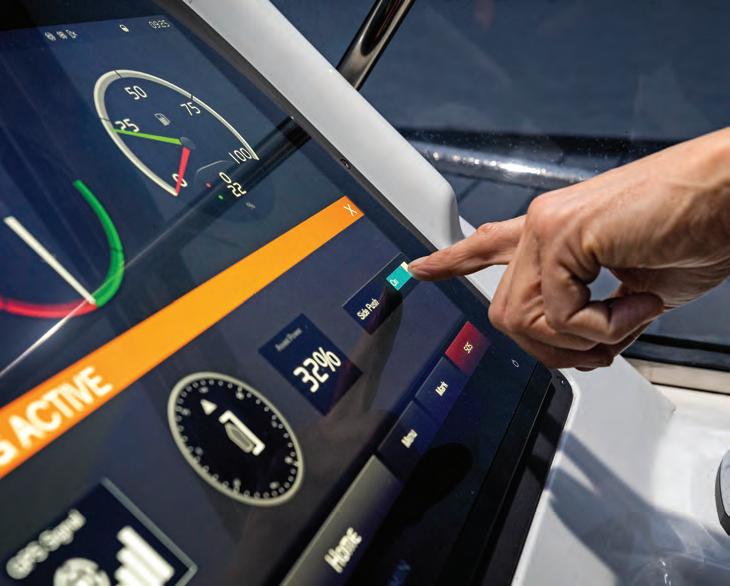
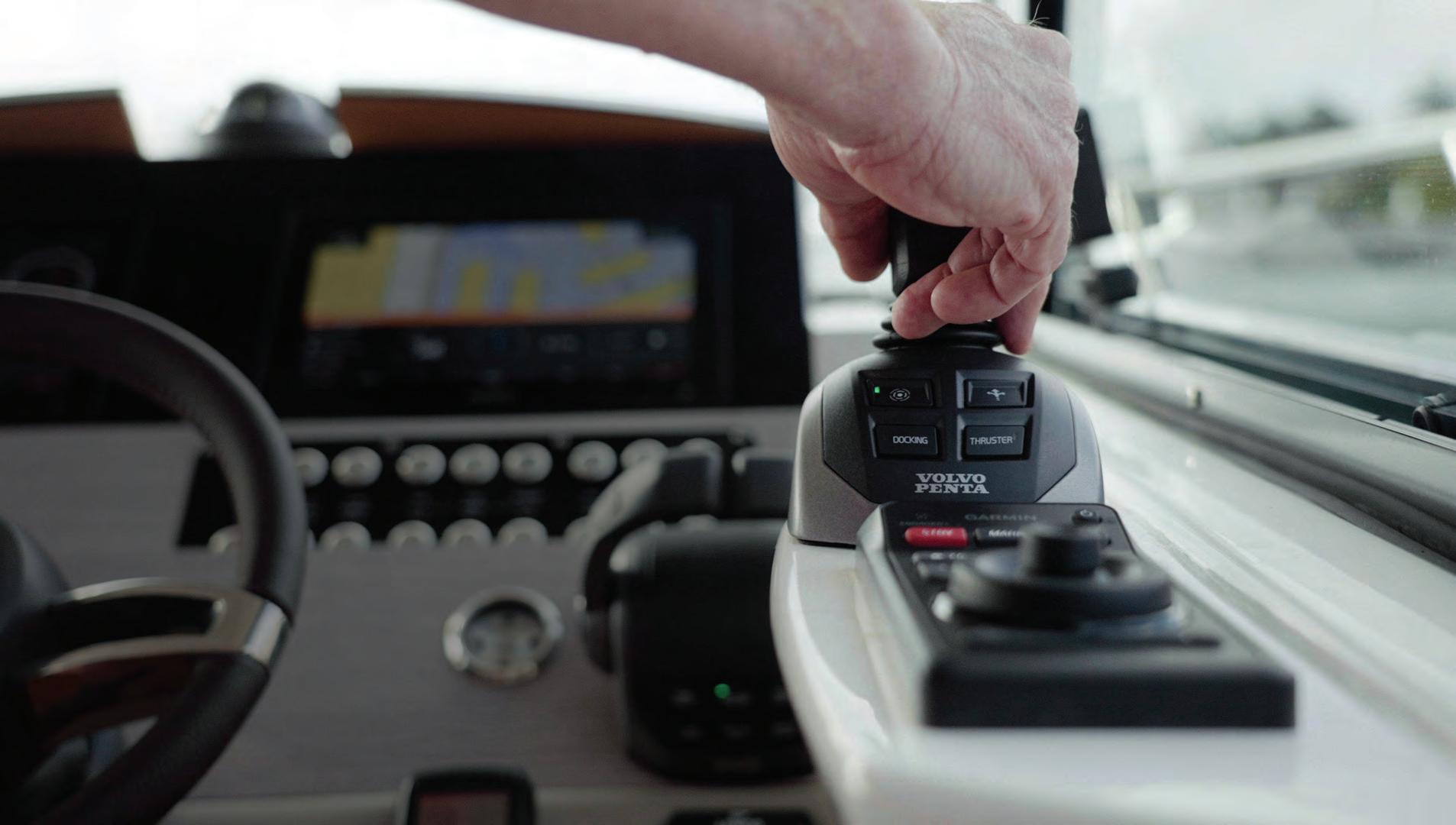




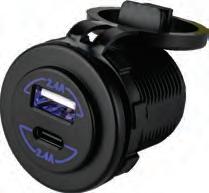


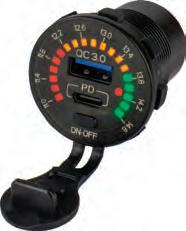
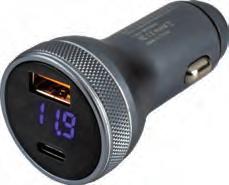

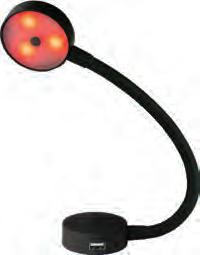


For its 76th installment during February 3-11, the Seattle Boat Show is freshening up its seminar slate with a boatload of brand-new, on-trend offerings.
 By Kate Calamusa
By Kate Calamusa

It’s almost time: The 2023 Seattle Boat Show comes into port next month. The beloved Northwest event will fill almost every corner of Lumen Field Events Center and Bell Harbor Marina, and feature over 800 of the latest and greatest model vessels, almost 300 exhibitors, and 110 hours of informational seminars covering almost every aspect of the maritime pastime. A longtime hallmark of the show, these sessions have always been a popular draw amongst boaters looking to boost their knowledge—and this year, the offerings have been bulked up with a wide array of fresh seminar topics. (In fact, thanks to effort by the team at the Northwest Marine Trade Association, 25% of this year’s seminars are brand spankin’ new.) Here, several of the experts preparing for the show give NWY readers an exclusive sneak peek at their seminars, which focus on forward-reaching fields such as marine communications, electrical refits, hybrid propulsion systems, safety innovations, and more. Prep your calendars, then sit back and enjoy the show.
February 4 @ 3 p.m.
[In a Nutshell] “Seattle Boat Works has been doing custom conversions from diesel to electric propulsion for over a decade,” states Wilken. “I will share my experience with boaters by going over the concepts of electric versus combustion systems, benefits of electric propulsion, types of and improvements in battery chemistry technology, and understanding hybrid systems.”
[Expert Resume] “The seminar is based on real world installation examples I have done over the past 10 years as part of my business (Seattle Boat Works) that have given me an in-depth understanding of electric motors. I'm also a certified marine mechanic, accredited installer for several electric propulsion brands, USCG Captain, and a full-time, live-aboard boater myself. My own boat has been my home for 36 years!”
[Why Now] “Boaters are often unaware that marine electric motors have been around for decades, from the state ferries to US Navy submarines. We often have to tell our customers we’re not inventing electric motors from scratch, just helping them put together a system from tried and true manufacturers that works for their boat and needs. The new thing is that the demand for electric and hybrid systems has gone through the roof, and LiPO4 batteries, which are safe for marine use and have become much cheaper, hold so much more power in a much smaller space. Overall this means there are more and more options for a range of boat sizes, and investing in an electric system doesn't just have to be for the commercial boaters. Most boaters think electric propulsion is about saving the planet or a green option. While it can be, the real secret is that the benefits are in the improved experience and expense. Maintenance, clean-up, and noise reduction can be the most difficult parts of a boater's experience, and electric or hybrid systems can solve so many of those problems.”

MARGARET POMMERT
20 Favorite Boating Innovations February 8 @ 1 p.m.

[In a Nutshell] “Boating is a relatively safe sport, and most hazards can be controlled with proper equipment and training,” Pommert asserts. “I will discuss innovations in a variety of areas, including rescuing crew overboard, navigation, first aid afloat, fire safety, weather awareness, and emergency communications. The focus is not bleeding edge technology, but innovative tools proven effective by Pacific Northwest boaters.”
[Expert Resume] Pommert has been a longtime safety advocate in the region. “I chair the US Sailing Arthur B. Hanson Rescue Medal Award Committee, a national award which recognizes a significant accomplishment in seamanship that has saved a life, and collects case studies in rescues for analysis by the US Sailing Safetyat-Sea Committee. As VP for Safety at Sea for The Sailing Foundation, I organize our annual hands-on Safety at Sea training in which lessons learned from recent incidents are shared. I’m an appointed member of the Washington State Boating Program Advisory Council, providing recommendations on ways to enhance boating safety across Washington. I’m also a very active instructor for several of the larger Pacific Northwest sailing and power-boating schools.”
[Why Now] “With inflation, many of us are looking for ways to safely enjoy boating on a budget. Several of these innovations help do just that,” she says in conclusion. “And some of my favorites are even free!”
 NANCY ERLEY & JO ABELI
NANCY ERLEY & JO ABELI
worked on projects ranging from full repowers of live-aboard yachts, to bonding systems on wooden fishing vessels, to programming app-integrated vessel monitoring and switching.”
Considerations
February 4 @ 6 p.m.
[In a Nutshell] Nancy Erley, an ocean sailor, and Jo Abeli, a marine electrician, will tackle the planning process and new technology available for upgrading your boat’s electrical system. Collaborating on the electrical modernization of Erley’s 1982 Orca 38 Tethys, they share the choices they made and why. States Erley: “You will see how to weigh the many considerations to achieve a balanced and elegant refit of your boat. Bring questions!”
[Expert Resume] “As a boat owner for 47 years, I’ve [Erley] fixed numerous electrical problems during two circumnavigations. Now it’s time to modernize my boat’s electrical systems and I’m so pleased to work with Jo Abeli, an ABYC certified marine electrician, and just the right person to bring Tethys into the modern age. Jo has
[Why Now] “The innovations in marine electrical systems, batteries, and solar panels have moved at a quick pace—faster than most boat owner’s projects. This new generation of marine electricians have been trained on the latest systems and technologies, whether it’s lithium battery technology, Bluetooth enabled sensors, or solar panel options. The components we will be installing as part of Tethys’ upgrades have been around for several years, and many boat owners will be familiar with them or at least heard of them. What some vessel owners may not know is just how accessible and user friendly a lot of the technology has become, and how many options are out there. For example, improvements in monitoring of electrical systems via Wi-Fi or Bluetooth can provide a record of history and trends over time. This can be useful for boat owners to improve safety on board and maintain the parts they invested in, and they can be powerful troubleshooting tools for technicians.”
RICHARD ANDERSON
HowtoWorkRe’BOAT’ly’:AdvancedInternetforEntrepreneurs,RemoteWorkers&DigitalNomads
February 3 @ 6 p.m.
+
InternetEverywhere:SatelliteInternetinthePacificNorthwestandBeyond February 9 @ 4 p.m.

+
EverythingYouNeedtoKnowaboutStarlinkforBoats February 11 @ 1 p.m.
[In a Nutshell] In the first of three seminars that Anderson offers over the course of the week, he offers his best tips for sailors seeking to work reboatly: “This particular seminar is for business owners, entrepreneurs, remote workers, and digital nomads who need the internet for their income. We will discuss how to combine Wi-Fi, cellular, and satellite technologies into a single reliable internet connection for phone calls, video conferencing, web browsing, and other business needs. Their clients will never know they are on a boat!” Mid-week, he tackles the more specific aspects of satellite connections available to boaters while cruising the Pacific Northwest waters: “This high level seminar covers the satellite options available today and in the future, including Starlink, as well as how the region, geography, and vessel itself affect the performance of each option,” he says. “We will place special emphasis on the latest options for the U.S. West Coast, the Inside Passage, Southeast Alaska, and Mexico, as well as global options for the intrepid explorers in our midst.” And finally, Anderson tackles arguably the industry’s buzziest new tech for his last seminar: “It covers everything you ever wanted to know about Starlink and its use on boats—how it works, where it works, what is costs, differences between plans and hardware models, how to power it, how to mount it, limitations, risks, and how to enhance the reliability of the service with additional hardware. All of my clients are asking about it, wanting to know if they should get it, which version to get, how it works, and what else they need. It’s a very hot topic!”
[Expert Resume] “I have 20 years of corporate IT and IT sales experience, including satellite networking, prior to quitting my old job and going cruising on a sailboat with my family. We actually ran three businesses remotely from the boat using a variety of Wi-Fi, cellular, and satellite technologies.”
[Why Now] “Since Covid started so many people have chosen to change their lives, get out of traditional office work or jobs, and travel or live aboard boats (as well as RVs, and et cetera). But these same boaters need some of the traditional things we take for granted at home like reliable internet. Many new boaters are also not retired and still need to work to support their families and their new lifestyle. It’s possible to create a reliable office-like connection to conduct business from practically anywhere and continue to generate income even when you aren’t in your office.”
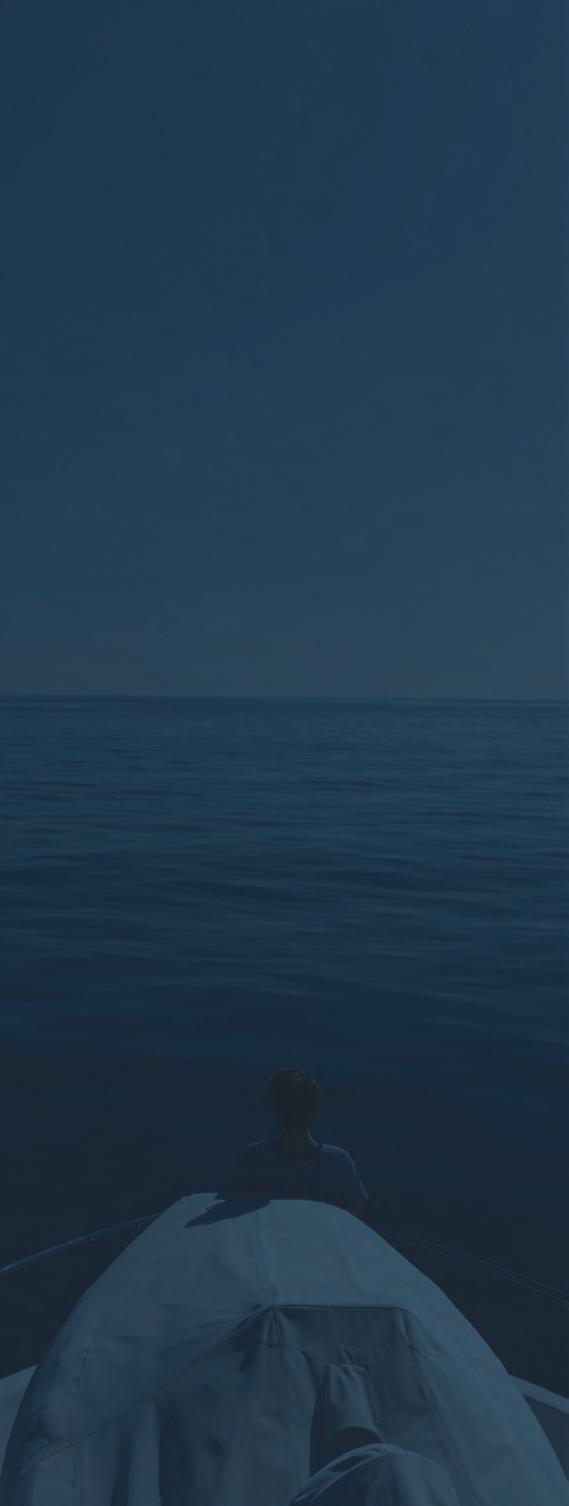
BeyondYouTube:LessonsLearnedfrom400,00000Miles
February 4 @ 2 p.m.
[In a Nutshell] John Neal sailed from Seattle on a Vega 27 in 1974 and has never looked back. “If you’ve gotten the adventure bug from watching YouTube sailing channels, this seminar shows you how to get from dreaming to experiencing your own blue water sailing adventure,” he says. “Here, learn how to find, purchase, and outfit a boat, how to qualify for insurance and how to sail it safely anywhere in the world.”
[Expert Resume] “I’ve sailed the equivalent of 16 times around the world and helped more than 11,000 people achieve their own dreams of worldwide sailing adventures.”
[Why Now] “This seminar is cutting edge because since Covid there are thousands of people dying to get on their own boats and sail off into the sunset. I cover all of the latest developments in gear and electrical systems. Plus, a detailed two-page checklist is included, and a 270-page textbook is available.”
BluewaterCruisingNowPanel:Trends, RevolutionaryGear,andTimelessTips
February 4 @ 11 a.m.
+
South to Mexico & West to Australia February 5 @ 1 p.m.
+
Self SteeringWindvanes:YourBestCrewMember February 4 @ 1 p.m.
[In a Nutshell] The Currys will help lead a Saturday panel that features experienced cruisers, including John Neal: “We love to talk about the incredible world of cruising: what’s better than traveling the ocean with your home? We chat about boat and passage planning, sailing trends, offshore gear, and timeless tips for life at sea. The passage down the Washington/Oregon coast can be a first and intimidating one for many. We share options for safe passages south to Mexico, and inspiration for making the decision to go... and go further.”
[Expert Resume] “We hatched a plan to sail to the South Pacific on our very first date. During our years of planning and saving, I [Sarah Curry] listened to every cruising seminar at the Seattle Boat Show… multiple years in a row! Since setting off from the Pacific Northwest in 2013 we’ve owned three sailboats, had countless experiences, and made a mistake or ten. Our current adventure (with our growing crew, 3½ -year-old twin boys) has us starting a little further east: a catamaran in Greece.”
Plan ahead and snap up the $99 seminar package which entitles you to a multi-day pass to the show and access to all of the seminars both live at the show and online after for 90 days. (With the $119 package you’ll also receive a 2023 Waggoner’s Cruising Guide.) For the most current details and a complete roster of this year’s Seattle Boat Show seminars, which include boating and fishing options, plus Boat Show University, as well as general information on the full event that runs from February 3-11, go to: seattleboatshow.com.
[Why Now] “The year 2023 is being defined by the obtainability of cruising as a lifestyle. You don’t have to have the perfect boat. You don’t have to leave a career at home; perhaps you work remotely (Starlink is the biggest technical innovation in years). The trend that has been flourishing is an attitude thing—young cruisers (and the young at heart) are inspired to see the world and are taking the ocean by storm. It’s a beautiful and exciting way to live and there’s a huge community of like-minded sailors waiting to welcome you. Our seminars are not all fluffy. We understand the seriousness of sailing offshore, and present about self-steering systems and emergency steering too.”
>> MORE ON THE DOCKET: Go to nwyachting.com/welcome-to-the-show/ for an exclusive look at even more new seminar topics, covering everything from new boating apps to advancements in green tech.

OLD MEETS NEW: A CLASSIC RUNABOUT EQUIPPED WITH A PURE WATERCRAFT SYSTEM FLIES ACROSS THE WATER.

Charged by their line of electric outboards, Seattle’s Pure Watercraft hopes to revolutionize e-boating with a little help from automotive battery tech.
 BY RANDY WOODS
BY RANDY WOODS
Gliding along the waters of Lake Union on a sunny fall day, the RIB tender gave hints that it was a bit unusual compared to most other small watercraft in Seattle. It was moving at a stately pace of two or three knots, but there were no engine sounds. Only the slight breeze and trickling bow waves could be heard.

This boat has some kick. One flick of the throttle and the RIB sprinted forward, reaching 20 knots in about three seconds. The wind and wave sounds grew louder, but the electric engine emitted a barely audible hum. Long as one held on tight in the lake’s chop, an onboard conversation could easily continue without raising voices.
At the helm was Gabe Johnson, head of marketing for Pure Watercraft, a Seattle-based manufacturer of electric outboard motors that launched in 2011, catering mostly to sport fishing boats and open-bow runabouts. “It’s not like a gas engine, it’s just pure torque,” Johnson said of the electric motor powering our ride that afternoon. “The power’s instantly there, so you just leap out of the water.”
The RIB tender, a 12-foot Highcraft, was created in cooperation with Pure Watercraft, but the chief product of the company over the last decade has been the sleek, low-profile powerplant in the stern. The 25-kilowatt outboard, weighing 112 pounds, uses a series of rechargeable lithium-ion batteries to deliver the rough electric equivalent of a 40 to 50 hp gasoline engine, but produces zero emissions and requires no regular maintenance.
“Any boat that can take an outboard can become electric,” Johnson said. “You can just remove your Mercury, drop in our motor, and bolt it onto the back. There’s nothing special about the boats.”
Yet something quite special will be happening this year regarding Pure Watercraft and boats. Sometime in the second quarter of 2023, the company will begin delivering a new line of boats that could revolutionize the use of electric motors in the United States and bring affordable battery-powered marine propulsion into the mainstream.
Get ready to meet the Pure Pontoon boat. And while the thought of spreading electric power to the world via lumbering aquatic party platforms may not initially seem to get the pulse racing, there is a strategic plan behind this pontoon.
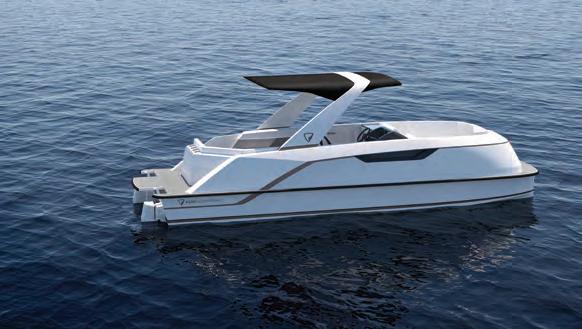
The key is market share, said Andy Rebele, the company’s founder and CEO. “Last year, about 70,000 pontoon boats were sold around the country,” Rebele said, which represents about 20% of U.S. recreational boat sales—a figure that has been growing by more than 20% annually. “They’re not fast, so they’re usually used as fishing boats for short excursions.”


“IT’S
CRAFTED IN PARTNERSHIP WITH HIGHFIELD, THE CO-BRANDED TENDERS ARE SPECIALLY MADE TO MATCH THE PURE OUTBOARD POWERTRAIN, INCLUDING UNDER-SEAT AND BOW LOCKERS.


More importantly, more than 50% of bookings for pontoon boats were for inland waterways last year, making them attractive beyond the usual boating hotspots on the coasts. “And since Covid began,” Rebele added, “pontoon boats have sold particularly well.”
These trends have not gone unnoticed by some deep-pocketed investors looking for growth in new green markets. In November 2021, Pure Watercraft inked a $150 million deal with automotive giant General Motors, giving it a 25% stake in the company, which is located right on Lake Union. While GM is noted chiefly for its gasoline-fueled cars and trucks, it has committed $35 billion, or 40% of its market cap, to the development of electric and fuel-cell vehicles of many types, including boats and locomotives.
In January 2022, Pure Watercraft debuted the first prototype of Pure Pontoon, using its own battery packs at the Consumer Electronics Show in Las Vegas. The company is now taking pre-orders for the production models, which will use GM’s batteries. The collaboration between e-cars and e-boats, Rebele said, is a natural fit. “GM battery packs don’t have to change when you put them in a boat,” he said. “They’re similar to the ones placed in their cars. And a factory made for pontoon boats is set up ex-


actly the same as a car plant, except the volumes GM can handle far exceed what we could do on our own.”
Under the deal, production of the Pure Pontoons would move from Pure Watercraft’s current Tukwila facility to a larger plant to take advantage of GM’s tremendous economies of scale. Last August, Pure Watercraft announced it will convert a former steel mill in a small town with the colorful name of Beech Bottom, West Virginia, to produce the Pure Pontoons. In turn, GM will supply the batteries and components, co-develop new products, and provide engineering and manufacturing expertise to Pure Watercraft.
While the hilly northern panhandle of West Virginia is not exactly known as a boating mecca, the property on the Ohio River, about 50 miles southwest of Pittsburgh, is well suited for distributing products to inland customers. “The assembly facility site will be ideal for inbound and outbound logistics,” Rebele said. Being more centrally located than factories in coastal cities and situated closer to other GM facilities, Beech Bottom can greatly reduce manufacturing costs, he said.
The converted 80,000-square-foot factory is set to open in late 2025, after a $5 million investment from Pure Watercraft, and expected to create more than 100 full-time positions in an area of Appalachia where new jobs are scarce.
But Pure Watercraft will very much remain a Northwest company, despite expanding eastward. Rebele said the company will continue to focus on its core electric technology by producing outboards, battery packs, throttles, and chargers at the current Tukwila facility. It will also continue working with Highfield Boats USA, which supplies the co-branded RIBs specially modified to match the Pure Outboard powertrain, including under-seat and bow lockers that accommodate the integrated battery packs.
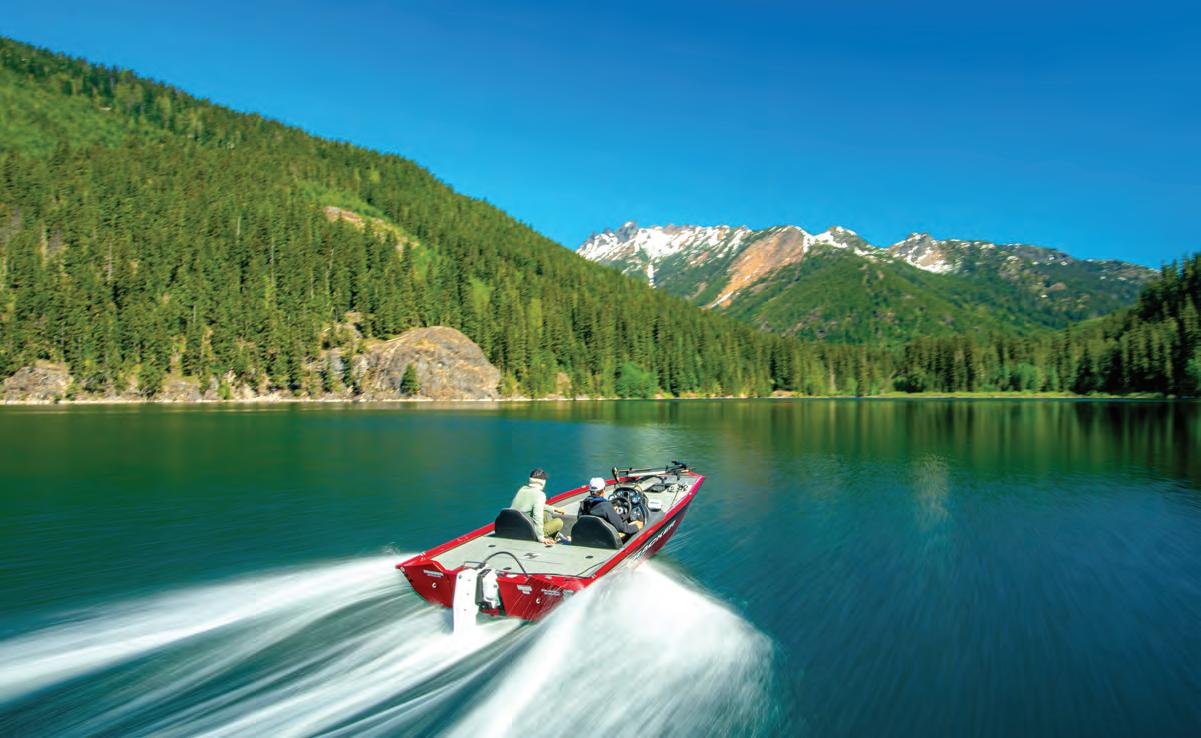
The Pure Pontoon design will possess a unique powertrain to really set it apart from other similar e-boats, Johnson said. “Electrics have been around for a while, but the battery packs are kind of our secret sauce,” he said. The 66-kilowatt-hour GM batteries, connected in a series by Pure Watercraft tech, provide more watts per pound than even the famous Tesla automotive batteries. “Watts per pound is the key metric because the power-to-weight ratio is so expensive in a boat,” Johnson explained.
Using a Level I charger, the Pure Pontoon’s batteries can reach a half-to-full charge in 30 hours at 110V, five hours on a Level II charger at 220V, and one hour from zero to 80% capacity with a Level III
fast-charger or supercharger. “If you’re tooling along at about three knots, you can go about 45 to 50 hours before you’d need a recharge,” Johnson estimated.
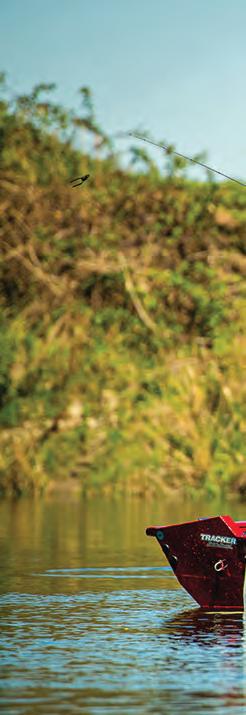
The Pure Pontoon has an overall length of 25’9’ and a capacity for 10 people, with ample bench seating and an optional bimini or hard top. Using Pure Watercraft twin electric outboards, the pontoons can reach a top speed of 23 mph. The range at top speed is 26 miles, or 120 miles at an average speed of 5 mph. The single outboard option can reach 14 mph and has a range of 32 miles at top speed.
“The battery packs are super small and can fit underneath the seats,” Johnson said. “Each one is just about the size of a suitcase. Depending on how you use the boat, each of the packs is equivalent to a three- or four-gallon tank of gas.”
GM has vastly improved the manufacturing efficiency of Pure Watercraft’s vision, but the small company made major strides on its own regarding the performance characteristics of the classic pontoon template. “Pontoon boats were never
“ANY BOAT THAT CAN TAKE AN OUTBOARD CAN BECOME ELECTRIC,” SAYS PURE WATERCRAFT’S GABE JOHNSON. “YOU CAN JUST REMOVE YOUR MERCURY, DROP IN OUR MOTOR, AND BOLT IT ONTO THE BACK.”
marketed on their efficiency,” Rebele said. “When they move, very little of the hull goes out of the water.”
To solve the problem of needing to push water out of the way, Pure Watercraft streamlined the pontoons to reduce the drag caused by the extra weight of the batteries. The curved point at the bow and the lightweight composite hull material require 20% less power to achieve the same speed as standard aluminum-tube pontoon boats, he added.
The company also added a simple midships foil running abeam between the two pontoons to give it added lift. The foil is fixed and located high enough so as not to affect the minimum draft, so the boat has no need for expensive mechanical foil retraction. “We didn’t know whether the foil would have a significant effect in the prototype, but it ended up being 21% more efficient than boats without a foil, and 50% better than other pontoon boats,” Rebele said. “People describe the foil effect as riding on a flying carpet.”
The Pure Outboard motor used on the pontoon craft also adds to the improved performance. The electric motors are up to 70% efficient, measured as the percentage of energy from the battery pack used for propulsion, not just in motor efficiency. Typical electric outboards range from 35% to 55% overall efficiency, while gasoline outboards achieve only about 5% to 15% overall efficiency.
Even the 16” diameter, three-blade propeller is designed to improve performance. “With electric motors, you can run at a lower rpm but use a larger propeller,” Rebele said. “If you used such a large prop in a gas engine, it might stall out because they have lower torque.” The 1,500-rpm motors are also low in diameter to benefit from passive cooling.
Because there is no impeller in electric engines, Rebele explained, there is no water intake, so they can run equally well in both salt and fresh water, with no need for a seawater loop flush. An electric engine’s gears are always engaged, so there is no need for shifting, which often causes the most wear and tear on gas engines. Pure Watercraft said their engines should last more than 10 years without any additional maintenance.
Pure Watercraft believes that the obvious environmental benefits of e-boating are not really the key selling point. The zero emissions aspect of the Pure Pontoon is being marketed almost as a fringe benefit for boaters, who tend to be more concerned with price and performance.
“It isn’t so much that its ‘green,’” Johnson said. “It’s the fact that it’s quiet, there’s no maintenance, and it’s way easier to operate than gas engines.”
When Pure Watercraft began showcasing its pontoon prototype around the country at events like the Fort Lauderdale International Boat Show, “the electric option was still kind of an oddity in the U.S.” Johnson said. “But in Europe, the majority of the focus is on electric.”
Affordability of e-boat technology is also a leading concern at Pure Watercraft. Thanks to the benefits of the GM deal, prices for the pre-orders of Pure Pontoons start at $75,000 for a single outboard and $90,000 for the twin-outboard package.

Finally, Pure Watercraft is capitalizing on novelty—a trait that is universally valued by boaters, regardless of geographic location. The Bluetooth-enabled ergonomic throttle on the Pure Pontoon includes an integrated tilt/trim button and GPS-enabled display screen that shows current state of battery charge, the speed of travel, and the travel time remaining.
“A lot of boating people just love gadgets and love talking about them,” Johnson added. “Electric power is the new toy everybody wants.”
>> For more details on Pure Watercraft, visit: purewatercraft.com.








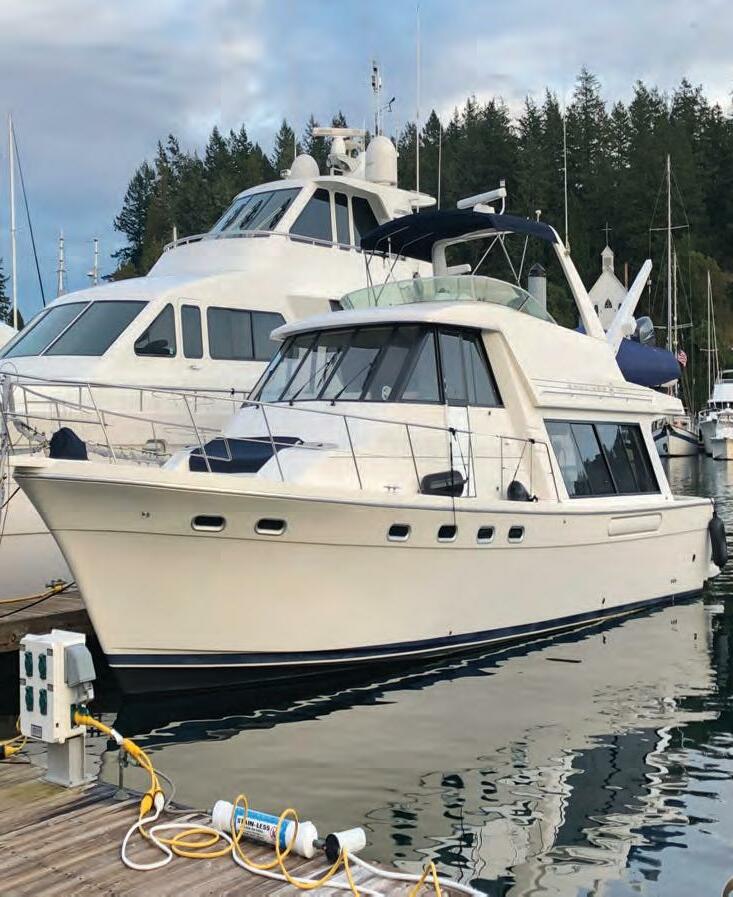
You are both avid anglers: What do you personally most enjoy about fishing here in the Northwest?

GH: For me, what I most enjoy is that fishing is something I can enjoy every month of the year. That’s actually one of the goals of the seminars at the show, to outline how to embrace fishing opportunities year-round here in the Northwest. I actually added up all the different types of fishing you can target here and I came up with nine: You have freshwater and cutthroat trout; squid; crab; halibut; tuna; lingcod; shrimp; and then of course, both Puget Sound and coastal salmon, which are two different techniques and fisheries, really. I can’t think of a lot of other places that have the sheer variety that we do.
KM: I would echo what George said about the variety and add that because of our year-round opportunities, there is always something new to try. Because we don’t have to put our boats away here for the winter, the season doesn’t end when summer does. Squidding is the perfect example of how to shake off the fishing blues during the darker months because it needs to actually be done in the dark—you shine lights into the murky water to attract the squid. You can go pretty much anywhere around here, too.
The fishing seminars offered at SBS are always a big draw; what do you think it is about this series that makes it so popular?
GH: Not all fisherpeople are boaters, but I have a pretty fun statistic to back up the idea that most boaters are fisherpeople. Year after year, a range of 60-70% boaters have reported that they use their vessel for fishing most of the time. I’d argue that number would be even higher here when you consider how popular crabbing is, too. So, I think to begin with, a lot of people are interested in fishing. But, also, one of the key things you really get out of the seminars is the background knowledge to help make you really successful at it, like very specific go-to locations and recommended times, tried and true tricks, and the like.
KM: I’d also say the breadth of knowledge among our speakers is pretty astounding. Keith Robbins is one of the best there is out there, and Tom Nelson from KIRO is just so enthusiastic; it’s pretty contagious to see the crowd engage with him and see what questions they ask.
Boating, and by effect fishing, has surged in popularity in the last few years, and there are a lot of new anglers out there. What should a beginning angler keep top of mind here in 2023?
GH: I think the first thing to ask yourself is what type of fishing are you interested in? Once you answer that, you can really pinpoint the discussions that will be most relevant to you at SBS. Also be sure to be on the up-and-up on the state’s fishery schedules. You first need to know when and where to go and there are specific seasons and time frames. Our seminars can really help you map out a whole year of fishing; you’ll be primed and ready to go on the right date if you plan ahead. Also, keep checking the dates, either on the state’s website or read Mark Yuasa’s column here in Northwest Yachting, to help you keep abreast of any changes.
Any interesting fishing trends you’ve seen emerging lately?
KM: A new one for me, and I’m lucky there is a seminar on this one this year, is that you can fly fish here in Puget Sound. I went out this year and filmed a webinar and did a trip with Keith Robbins and it was a fun reminder that cutthroat trout in saltwater is yet another year-round fishery; you just hit the beach with your fly rod. The other thing that’s gotten pretty popular is tuna fishing. Most folks think of Mexico or Southern California when it comes to tuna, but the truth is, we have huge amounts of albacore tuna that come through here. Tommy Donlin, who is one of the most passionate fishermen out there, is doing a seminar that I’m going to attend myself as I’m hoping to learn more about nabbing those—and navigating how to find them 20-60 miles offshore. Lastly, and I find this one really interesting, there has been a resurgence in mooching, as opposed to trolling, over the last few years when it comes to salmon fishing. Keith Robbins has been one of the big
proponents of the movement. I love it: there’s something pretty cool about getting back to basics, wielding the pole in your hand, and feeling the bite. The simplicity is alluring.

GH: Keith Robbins is always on my calendar; I love to spend time with him as I aspire to be an angler like him. And I pop by as many others as I can, too. I think it’s worth noting that though Karsten and I have had the benefit of knowing these experts for years, we learn something new every year. It’s like recapping a football game. Every year, the analysis and the strategies all change depending on how the last game, or in this case—fishery, went.
KM: To echo that, I always make sure to attend Tom Nelson’s salmon fishing to brush up and see what the latest, greatest techniques are. I also like his shrimp seminar; last time I was enthralled by his knowledge of scent trails when it came to shrimping. And I will add that beyond the seminars, the Q+A sessions are just amazing and I love sitting in on those. Everyone from a beginning angler to an expert can pipe up and tap into these speakers’ expertise, and someone always asks a question that I need to know the answer to.
About the Experts: George Harris is President/ CEO and Karsten McIntosh is the Director of Communications for the Northwest Marine Trade Association (NMTA), the organization behind the annual Seattle Boat Show that is set to kick off on February 3rd and run through February 11th. Along with Boat Show University and a slew of new boating presentations (see this month’s feature on pages 44-51 for a preview), the popular fishing seminars will cover a variety of Northwest-related angling topics from a trusted group of local experts. For more information on seminar topics and for a full schedule, go to: seattleboatshow.com/ seminars/

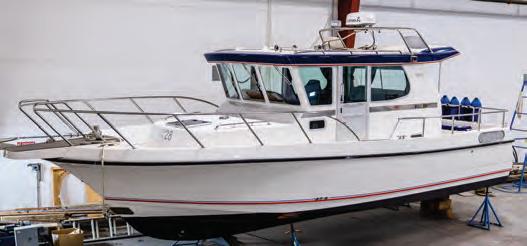









The New Year has arrived and I’ve got some fishing resolutions for you to set as immediate goals in the upcoming weeks:
Dance a Jig, Catch a Squid Squid jigging has seen boost in participation over the past several years due to easy accessibility and excellent catches when returns are strong. Migrating squid usually make an early appearance from September to October, but the optimal time is December through January. Good news: Recently, squidding around Puget Sound has seen improvements for anglers mainly in Elliott Bay and off the Edmonds and Des Moines marinas. Surrounding piers in Puget Sound have also picked up, although remain a bit spotty, good one day and bad the next.
Nighttime on a flood tide is usually the best period to give it a go as squid are attracted to lights beaming off the public piers. When fishing from a boat, dangle powerful lanterns just off the side of the boat and above the surface of the water. Use a seven- to eight-foot trout fishing rod and spinning reel with lightweight braided fishing line of 5- to 6-pound test.
The weighted jigs are luminous or light-up plastic versions in pink, chartreuse, blue, red, green, and orange. Jigs don’t have hooks and instead have upward slanting sharp prongs. When you get a squid on your line, keep steady pressure when reeling up and don’t jerk or reel quickly. Unweighted lures are also used by squid jiggers and attach to a one-ounce lead weight. The WDFW website has details on catching squid at: wdfw. wa.gov/fishing/basics/squid.
For those who prefer chasing salmon in saltwater locations, the only show in town is southern Puget Sound (Marine Area 13) where some anglers are quietly finding fair catches of winter hatchery Chinook salmon. The key to success in the winter is locating the schools of herring baitfish. Look for winter Chinook salmon around Gibson Point and Point Fosdick, Fox Point in Hale Passage, the northwest corner at the Sand Spit, Toy Point, and the Concrete Dock Fox Island Fishing Pier. Other deep southern sound spots are Nisqually Flats, Dover Point near Zangle Cove, Itsami Ledge, and Johnson Point.

Big rainbow trout are on top of the list of fish to pursue in north central Washington. Rufus Woods Reservoir on the Columbia River located between Chief Joseph and Grand Coulee dams is a well-known winter fishery where rainbow trout average 2 to 6 pounds, with some growing into the 20-pound range. The Colville Confederated Tribes (CCT), in cooperation with the Washington Department of Fish and
Wildlife, produce and annually release hatchery-raised rainbow. The three net pens produce about 14 million pounds annually.
These trout tend to grow rapidly and are simply focused on gorging off the ample feed found along this vast 51-mile stretch between the towns of Bridgeport and Coulee Dam. The reservoir water temperature needs to drop below 60 degrees, which usually happens in late November or December. That triggers their metabolism and makes them more active and easier to catch in the winter. Fish are attracted to the hatchery pellet food source leaking out of the net pens.
Access to the shoreline on reservation land near the net pens is allowed through the CCT. The western shoreline requires a tribal permit to fish. The nearest boat launches to the net pens are located at Tim’s Ranch and Coyote Creek. An annual permit to fish or use facilities on the reservation is $80. (To buy a permit visit: colville.nagfa.net/online/.) Never tie your boat to the net pens and be aware of underwater anchor cables attached to the net pens so you don’t get your fishing gear tangled up. Boat anglers should troll across the edge of the net pen’s bottom corner and upstream and downstream but make sure to stay outside of the buoy that marks the snaggy anchor cables.
The lower net pen is about 33 miles above Chief Joseph Dam, and the middle net pen is closest to the mouth of Nespelem Creek, where a flat is located. You’ll see many fly and bank anglers in this area.
Trollers can use a Rapala, Yakima Bait Maglip, Flicker Shad, Wiggle Wart, Flatfish or Kwikfish in bright orange or fire tiger. You can also surface troll a Wedding Ring with a nightcrawler or a large woolly bugger fly behind a wiggle fin action disc going 1- to 2-mph. Shore-bound anglers: Use a salmon spinning or casting rod and reel, and for bait, stick with Berkley Power Bait or a similar dough bait in bright colors like green, red, orange, pink or rainbow types. You can also try a marshmallow and shrimp or nightcrawler. Be sure to use a heavier slip sinker to keep it on the bottom depending on currents along with a heavy leader.
The daily limit at Rufus Woods Reservoir is two rainbow trout including kokanee with no size restrictions. Chumming is not allowed. At Rufus Woods or within the Colville Designated Fishing Areas, either a tribal permit or WDFW license is acceptable. A WDFW license is required when fishing from the Douglas County shoreline.
Bundle up and pack your gear—and I’ll see you on the water soon!
The Port of Everett Marina offers 5,000 lineal feet of guest moorage for visiting boaters and affordable, conveniently located permanent moorage just steps away from world-class amenities, waterfront hospitality, restaurants, outdoor activities and more to come!

Guest moorage is available on a first-come, first-served basis or by reservation via DockWA.com.

Contact us to reserve your slip today!
Call: 425.259.6001 Visit: portofeverett.com/marina
Free yourself from tangled cords with these useful wireless device picks curated by ANDREW HOGE.

Seattle-based Graypants is known far and wide for creating beautiful lighting devices, and their Wick portable light is no exception. It’s part candle, part flashlight—and a single charge will get you up to 70 hours of illumination, perfect for evening strolls on deck or docking late at night. ($149; graypants.com)
Like a hull and a sail, it is a universal truth that chilly winter weather and piping hot beverages go together. This minimalist electric water kettle is the perfect companion as you prepare your French press or breakfast tea, and its cordless carafe allows you to refill your cup anywhere on your boat. ($99.95; Available from Crate & Barrel, crateandbarrel.com)

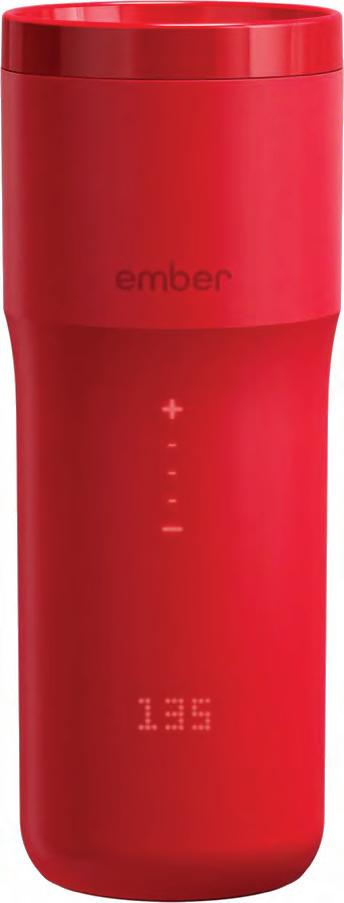
Pour your favorite hot beverage into this most recent version of the temperature-controlled mug from Ember, a NWY favorite. Whether you are planning to disembark for an all-day adventure or feeling too lazy to leave the deck, this elegant tumbler will keep your liquids perfectly held at
your desired temperature between 120-145 degrees with your phone or the tumbler’s touch display controls. ($199.95; ember.com)

Finding a portable speaker that offers equal parts sound and style in a sea (pun intended) to choose from takes a lot of work. Luckily, Sonos has you covered. Their Roam portable speaker will play your favorite tunes for up to 10 hours while effortlessly pairing with your phone or other Sonos devices. ($179; sonos.com)
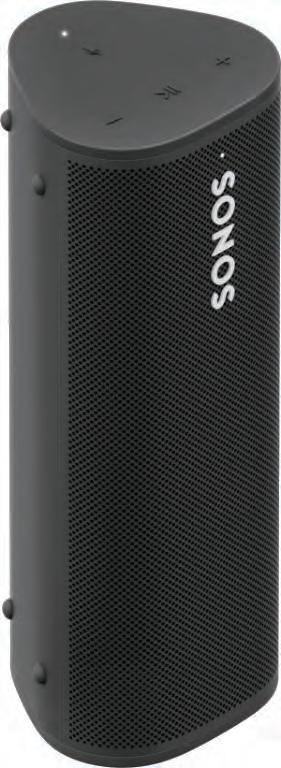
While a day at sea is a great way to escape landlocked life, there are times when you need to stay connected. So, don’t forget to pack a Solis internet hotspot before your shove off; it offers powerful 4G LTE Wi-Fi and can connect with up to five devices. ($99; soliswifi.co)
Andrew Hoge is a Seattle-based fashion, beauty, and lifestyle writer who covers the Pacific Northwest’s evolving style and cultural scene. Follow his perspective on Instagram at @andrewhoge.
• Instruction - Live-aboard power & sail courses. Beginner to advanced. Private instruction options available.


•
• Guided Flotillas - Enjoy the camaraderie and comfort of cruising with a guided otilla.

• Charter Ownership - Join the eet and let your quality, newer, cruising powerboat or sailboat work for you.

•

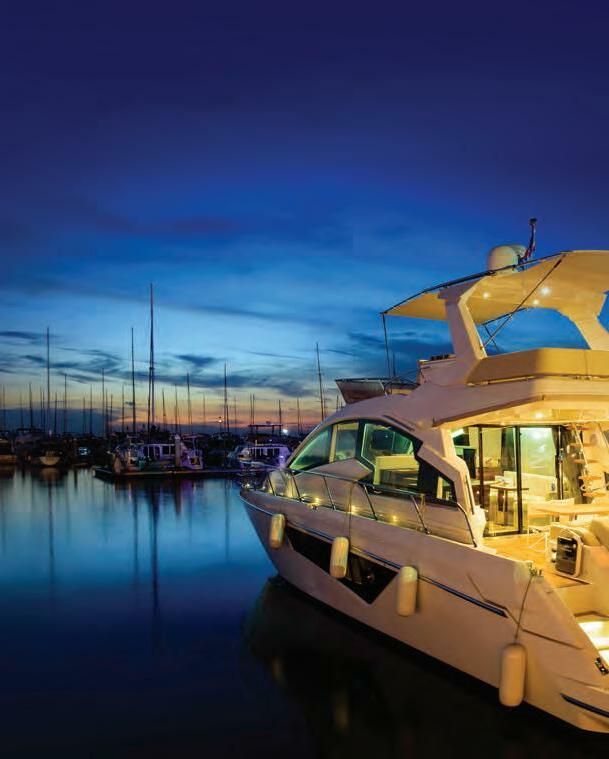




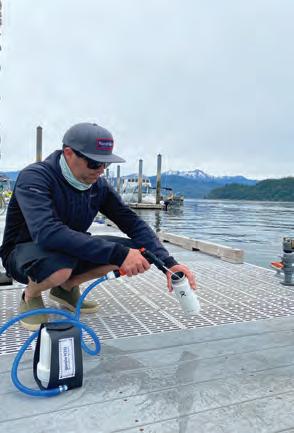
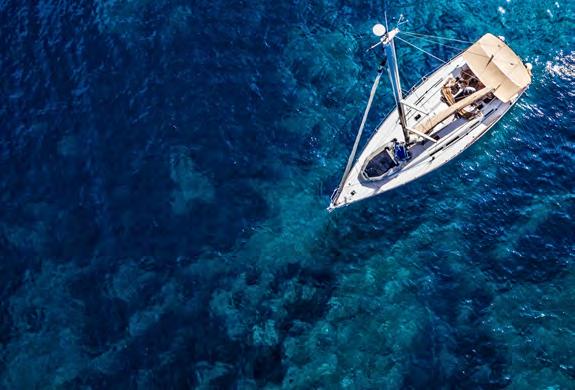




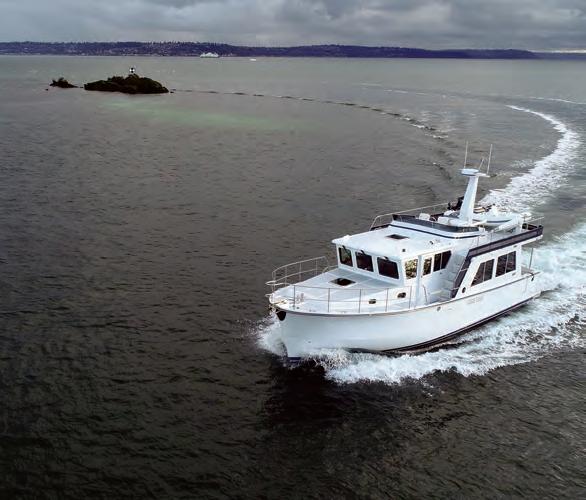

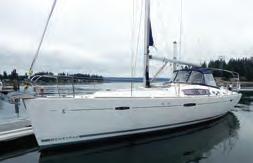
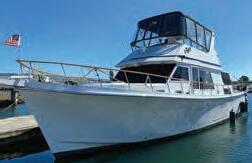
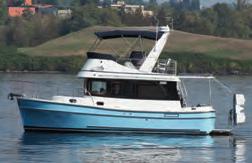

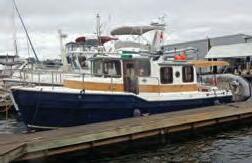


DOUG HANSEN recounts the Round the County race, a challenging yet cherished meet that circumnavigates the San Juan Islands.
There are certain cornerstones to the Pacific Northwest sailboat racing calendar—Swiftsure, Race to the Straits, and the Seattle Yacht Club Grand Prix are certainly on the list. All of these races bring something unique, whether that be a longer distance, some double handed sailing complemented with one hell of a party, or the competitive nature; they all have something special. While all of these races are beloved, if you ask sailors what their favorite race is, you will begin to notice a pattern, and once you understand the special draw, it is easy to see why Round the County is frequently the top choice.
The two-day, point-to-point race is hosted by Orcas Island Yacht club every November and is, at its core, a lap around the San Juan Islands. The racecourse starts off at the Lydia Shoal buoy just east of Orcas Island, and finishes day one at Roche Harbor. Day two takes the fleet back to Lydia Shoal for the finish. The unique twist on this event is that the direction of the race alternates year to year, even numbered years run clockwise, and odd years run counter. This year’s race had light air predicted in the forecast, but that didn’t stop 67 boats from filling out the registration list. Everything from big boats in the ORC fleet (with the very fast RP55 Zvi topping the entry list) to a pair of Santa Cruz 27s in PHRF Class 6 bookended the scratch sheet, with every manner of boat one could imagine in between.
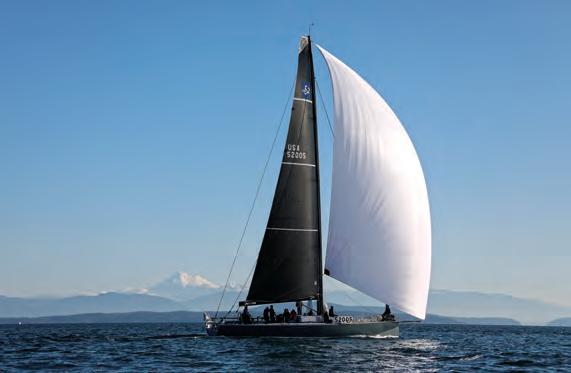
Things got going Saturday morning on time with a nice northerly that headed the fleet down the course, but the wind did not last. As the fleet arrived at Iceberg Point, things got light and stayed light throughout the day. A game of chutes and ladders then began, with the leading boats accordioning apart and back together as small, localized puffs of breeze came swirling off the shoreline. In general, sticking to the beach paid off big, with boats literally only feet from the rocky points and skimming along the shallows to avoid the current and stay in the whisps of wind.
The breeze began to fill slowly as the leading boats made their way around Lime Kiln Point and out of the lee of the islands, but it was far from a white-knuckle ride. The shore still paid big and short tacking with the bow of the boat just feet from the rocks was certainly a trust building exercise for skippers and navigators. The fleet came trickling into the finish
near Roche Harbor—one by one and in small clusters—wrapping up a very challenging day of racing, all be it one that many expected not to finish at all.
As the fleet tied up for the evening, Roche Harbor was in full swing as the entire town was sold out and packed to the rafters. The epicenter of the festivities was the party tent afloat in the marina, with live music, drinks flowing, and dancing all roaring well into the evening. (To say that the party isn’t a factor in the event’s popularity would be a bold-faced lie.)
Sunday morning had a bit more excitement in the forecast with again a steadily building northerly in the report. However, as with many things when it comes to sailing, there are no guarantees and while there was good wind for the start, it quickly gave way to light bands of pressure and swirling currents as the mass of boats made their way to the halfway point at Patos Island. Things began to look up as the leading boats rounded and set spinnakers, with the breeze steadily building into the mid-teens during the kite run, making for some exciting moments while crews worked to gybe in and out of the islands to get out of the negative current flows.
Like clockwork, the breeze was not meant to hold. As the racers rounded Orcas Island and pointed towards the finish, the wind went light thanks to the massive wind shadow behind Mount Constitution. Getting swept past the finish by the current was an absolute death sentence, so a lot of patience and foresight was required to make it cleanly across. With the flowing current it felt a bit like docking the space shuttle, as you had to set up to vector the boat across the finish line from nearly a mile out in the swirling current and glass calm wind hole.
It is no secret that many events are working hard to recruit participants, but somehow this one seems to have no such struggles. It is an anchor point in many racing programs’ calendars and it’s easy to see why: stunning scenery, often good wind, and a true “event” feel thanks to the stopover; Round the County encompasses the perfect balance of adventure and competition that the weekend warrior sailing crowd hungers for. While this event is difficult to duplicate, it would be a shame for any event organizer not to look at it for inspiration.
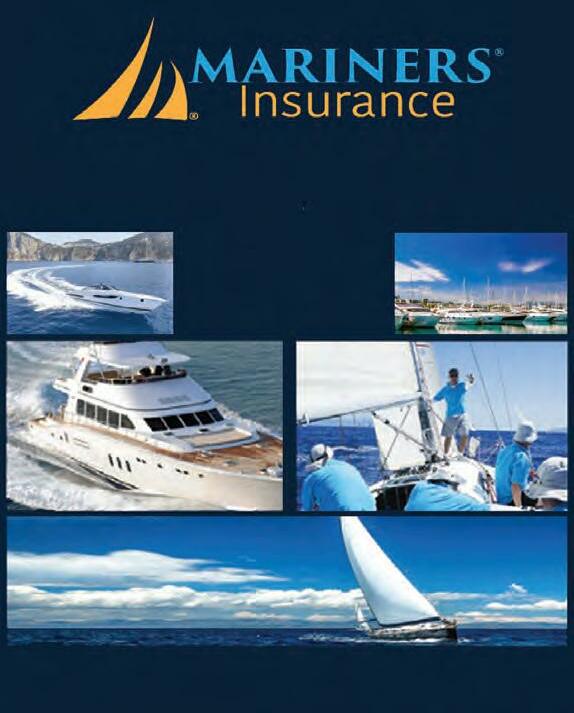

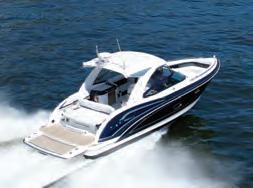
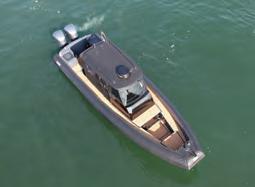


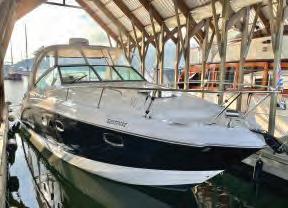
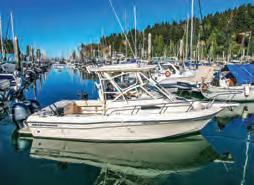














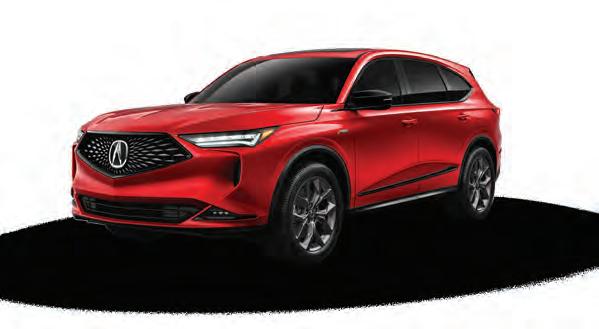



Creamy, velvety smooth, and packed with luscious king crab, this beautiful bisque from CHEF JOHN WAHLKE and FREMONT MISCHIEF DISTILLERY is sure to combat the winter chill.
Here’s a rich, smooth, and creamy bisque—just one of many memorable recipes that will be featured later this year in Spirited Cooking from the Pacific Northwest, the cookbook I assembled with Chef John Wahlke and owners Mike and Patti Sherlock of Fremont Mischief Distillery. This delicious and comforting bisque—perfect for those cold winter months—is filled with rich crab flavor and accompanied by homemade pickled peppers. Like many of the enjoyable dishes prepared at Mischief, this hearty bowl of goodness is fancy enough to serve for a special occasion but easy enough to appreciate as a weeknight dinner in your galley. Vegetables, cream, stock, and a handful of spices make up the king crab soup, which is much thinner than a chowder. If you’re not familiar, a bisque is a type of soup, but not all soups are bisques. Traditionally, a bisque uses stock or broth and has a creamier base than soup. According to Chef John, the trick with this recipe is to blend and strain, resulting in the velvety smooth texture we’re after.
Serves 4 to 6
2 tablespoons oil
King crab shells from 2 large legs, roughly chopped or broken
1 carrot, peeled and chopped
2 onions, peeled and chopped
4 shallots, peeled and chopped
2 stalks celery, chopped
5 garlic cloves, peeled and crushed
2 cups dry white wine
Sachet of 3 bay leaves and 4 fresh thyme sprigs
2 ½ quarts vegetable stock or water
2 tablespoons kosher salt
1 teaspoon fresh ground white pepper
2 teaspoons smoked paprika
2 teaspoons mustard powder
1 cup half-and-half, divided
King crab meat, as needed, picked 12–18 (or 3 slices per bowl) Pickled Pepper slices, recipe follows
In a large stock pot over medium-high heat, add the oil. When hot, add the king crab shells, stirring often to not scorch the oil. Add the carrots, onions, shallots, celery, and garlic. Sauté while stirring occasionally until the onions and shallots are translucent. Deglaze the pot with the white wine and allow the wine to reduce by half. Add the sachet along with the vegetable stock or water. Bring to a boil, then reduce the heat to low and allow to simmer. Add the salt, pepper, paprika, and mustard powder. Stir to combine then simmer the stock for 1 to 2 hours, or until the liquid has reduced by half. Remove the sachet and transfer the stock, vegetables, and shells (6 ounces at a time) to a kitchen blender (about half full). Blend, starting slow as the liquid is hot, slowly increasing the speed. Blend until smooth. Then add 1 ounce of half-and-half for every 6 ounces of stock (or one batch). Continue blending and adding the half-and-half in batches until you have blended all the soup. Then strain the blended soup through a fine mesh strainer or chinois. Before serving, reheat the soup (160°F), but do not bring to a boil. Check the seasoning then transfer to serving bowls garnished with a generous amount of king crab meat and sliced peppers.
Makes 1 pint
1 quart apple cider vinegar ¼ cup granulated sugar ¼ cup salt 2 sprigs fresh thyme 1 cup water ½ pound fresh Fresno chili peppers
In a large pot over high heat, add the vinegar, sugar, salt, thyme, and water, and bring to a boil. While waiting for the liquid to boil, slice the peppers. Transfer to a glass canning jar. When the liquid has come to a boil, remove from heat and carefully pour over the peppers in the jar while still hot. Cover the container with either plastic or a lid and let stand out at room temperature for 2 hours before refrigerating. Sealed peppers will last about 1 month in the refrigerator.
A James Beard Award–winning cookbook and cocktail author with more than 40 published titles to his credit, Fraioli’s books have been featured on Ellen and the Food Network, and in Vogue, People, Forbes, the Wall Street Journal, and The New York Times. He resides in Bellevue, but keeps his sportfishing boat (a 28-foot Albin) in beautiful Anacortes, the gateway to his beloved San Juan Islands. Have a cookbook idea or project in mind? Email james@culinarybookcreations.com.









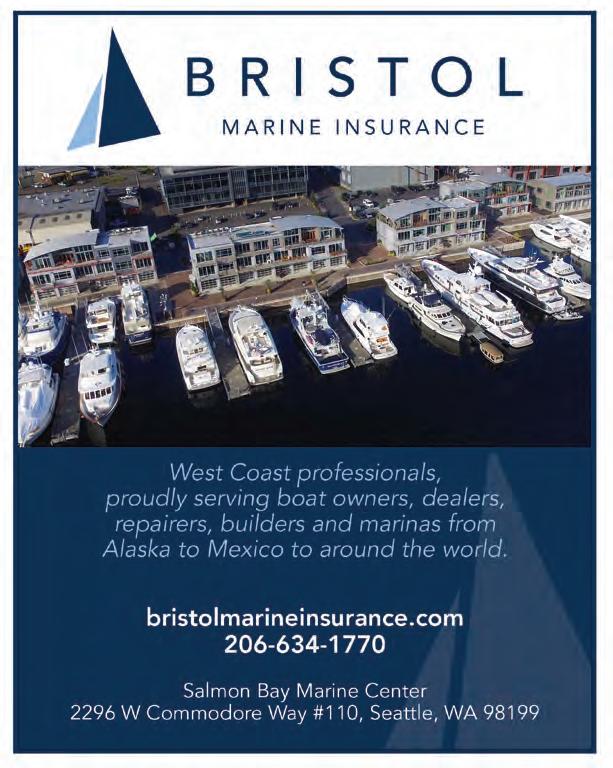




With
Unspoiled and less crowded than other areas in the Caribbean, Belize is a laid-back paradise very similar in vibe to the cruising grounds of the South Pacific. Boasting world-class snorkeling and scuba diving, superior chartering in protected waters, and unparalleled natural beauty, this tropical delight offers a special yachting destination.
The small country in northern Central American is just slightly larger in geographical size than the state of Massachusetts. Mexico is located to the north and Guatemala to the west, while the western Caribbean fronts the remainder of the country. One of the most remarkable features of Belize is the Mesoamerican reef that stretches approximately 350 nautical miles from the tip of the Yucatan Peninsula down along most of the Belizean coast. (Only Australia’s Great Barrier Reef is larger.) The reef shelters more than 400 cayes and most are fringed with additional reefs comprised of at least 50 species of hard and soft coral. Manatees, whale sharks, and over 500 species of tropical fish thrive in these waters. Up above, all manner of birds frequent the skies, including the magnificent frigatebird and brown booby.
A yacht charter through these waters naturally focuses on the superlative onboard experience as you cruise the palm tree-fringed and
mangrove-lined coasts. However, a Belize yacht charter can encompass so much more, and often does. Imagine: embarking on a guided dive to the Great Blue Hole, a geological wonder of the world located within Lighthouse Reef; sampling local cuisine and experiencing the Belizean culture while exploring on land; or touring the stunning ancient Mayan ruins of Xunantunich. It’s all yours for the taking.
Arrive at sunset for evening cocktails, followed by a delightful dinner prepared by your chef. As you settle into life onboard, take in the cityscape of Belize City. Perched on a peninsula, this vibrant city even features an artificial beach built for the visiting cruise ships.

This private island is located an hour outside of Belize City. The short cruise makes it a perfect destination after your sunset cruise. The white sand beaches and shallow waters are ideal for a day spent on the beach. Lounge in the crystal clear waters while drinking rum punch.
After a short two-hour cruise, arrive at Turneffe Atoll. One of three atolls along the Belize Barrier Reef, this is an ideal location to spend the day exploring the ocean. The premier fishing and diving here ensure you’ll enjoy every minute.

The easternmost section of Belize’s Barrier Reef, Lighthouse Reef is the perfect location for diving. Home to the Great Blue Hole, your dive experience is sure to be unique. This is also the site of the country’s oldest protected wildlife sanctuary, so your cruise is sure to produce many colorful and unique sightings.
Half Moon Caye is a natural wonderland as this nature reserve is home to 4,000 red-footed booby birds. Be sure to hop in the tender and head ashore to find a nature trail that leads to an observation platform with extraordinary views of the idyllic scenery.

Hatchet
Anchor near Hatchet Caye where you can spend time enjoying your yacht’s plethora of water toys. Paddleboard through the smooth seas before enjoying lunch served al fresco on the aft deck. Finish the day with an adventurous attempt to water ski.
Boasting gleaming white beaches, Queens Caye is the perfect island to visit for some sun bathing. Here, you can also anchor in about 20 feet of water that’s excellent for snorkeling and spying the 80 species of fish that swim through the coral infrastructure in these waters. Diving offers excellent walls, grottos, and canyons ranging from 35 feet to 3,000 feet deep.
Discover the extensive flora and fauna of Belize while on the Monkey River Magic guided tour of the Monkey River. After spending the day adventuring, enjoy dinner at the French Connection Restaurant, voted best food in Belize.
Every year, from March through June, whale sharks migrate approximately 26 miles off the shores of Placencia, in an area known as the Gladden Spit Cut. If you are lucky enough to visit during that time, you’ll have the opportunity to swim with these magnificent creatures, yet another bucket list item that you can tick off in this beautiful country.
Lori Eastes is thrilled to be on the team at Worth Avenue Yachts because chartering private yacht vacations combines everything she loves: party planning, travel, and boats. With a background in hospitality, Lori is committed to providing an unparalleled experience for her clients. To chat with Lori about making your yacht vacation a reality, give her a call at 206.209.1920.
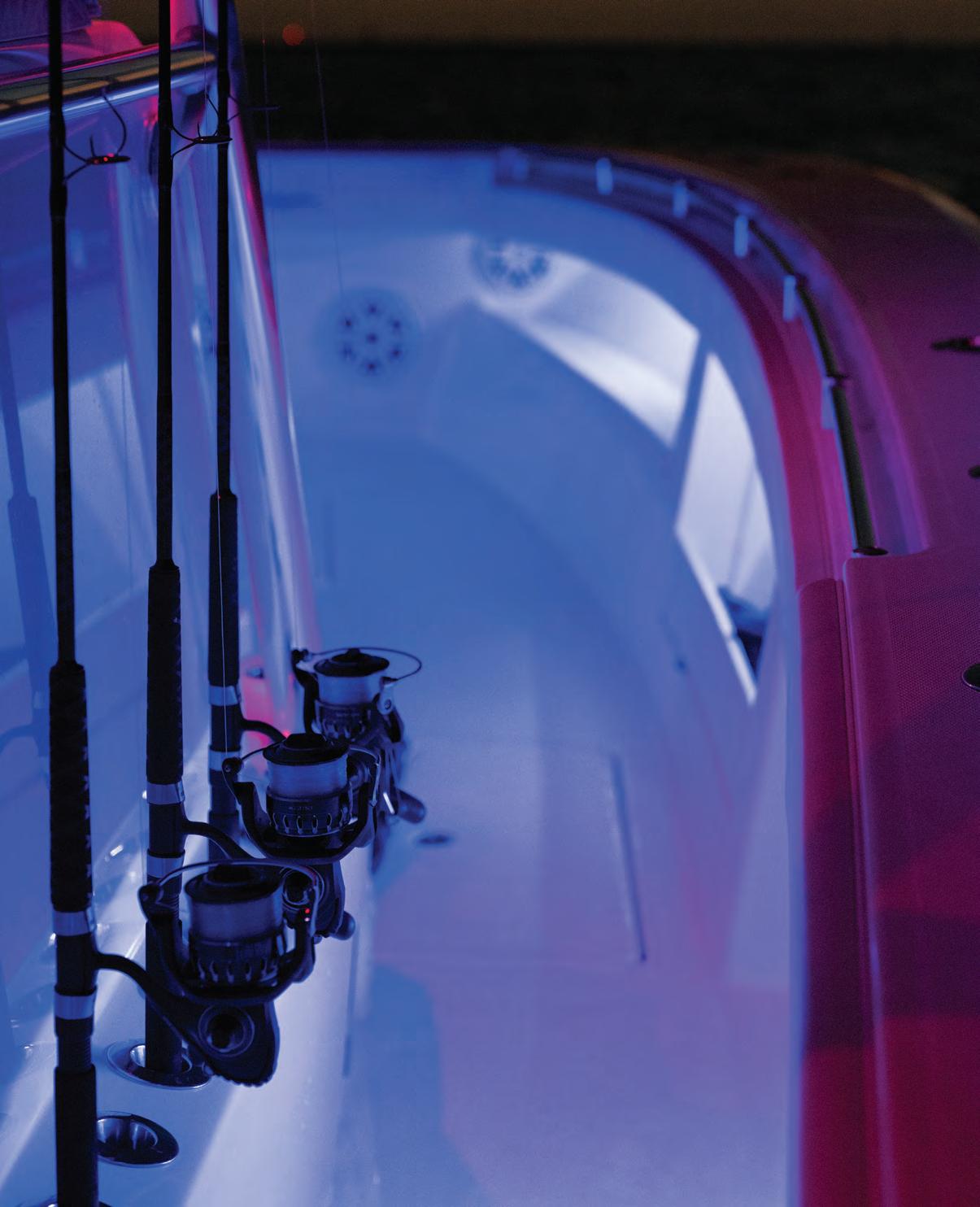
“THE CHARM OF FISHING IS THAT IT IS THE PURSUIT OF WHAT IS
BUT
– John Buchan
Discover the world with Worth Avenue Yachts. Our dedicated charter team will guide you through the incredible destinations ready to book for your next vacation.

Chartering your private yacht is the most effective way to maximize return on your luxury investment. Charter income can offset the costs of ownership, such as maintenance, running costs and crew salaries.
Our team of experts is standing by to assist you in legally chartering your yacht in the Pacific Northwest and beyond. If you are interested in putting your existing yacht into a charter program or purchasing a yacht to earn a charter income, contact our team today - (206) 209-1920




 Stephanie Gilmore -
Sally FitzgibbonsKelly Slater
Stephanie Gilmore -
Sally FitzgibbonsKelly Slater